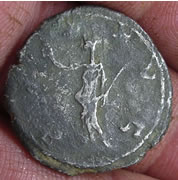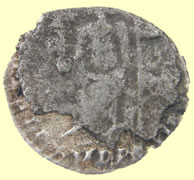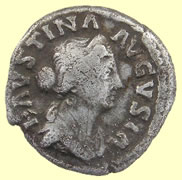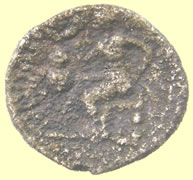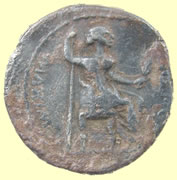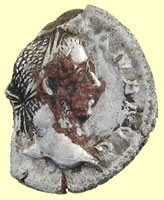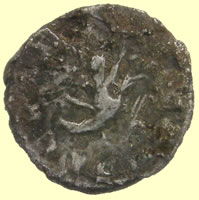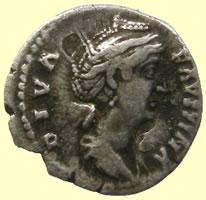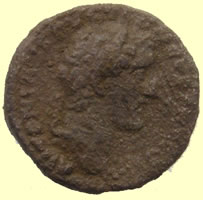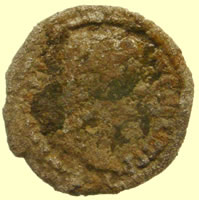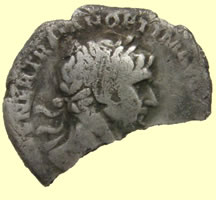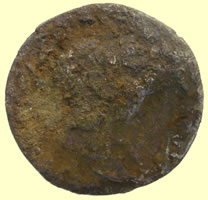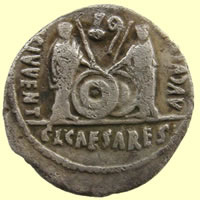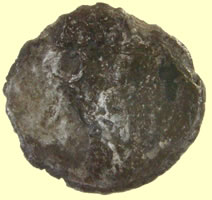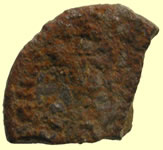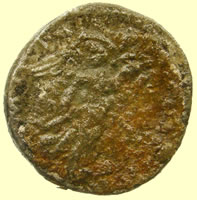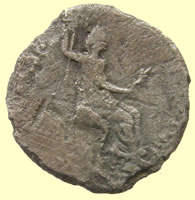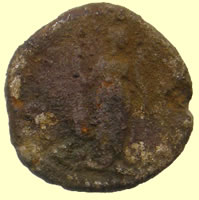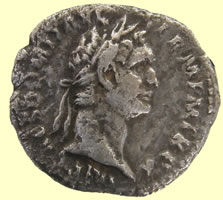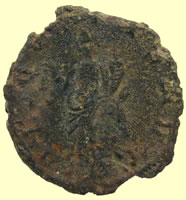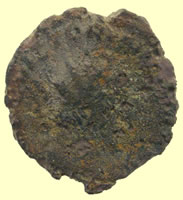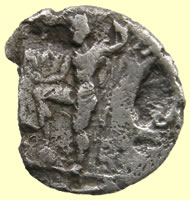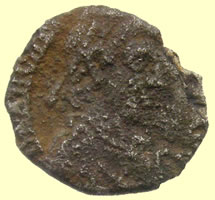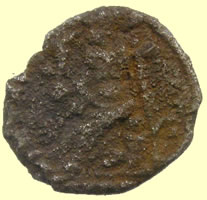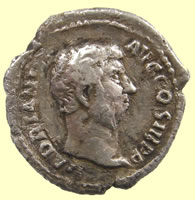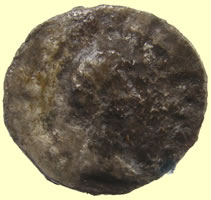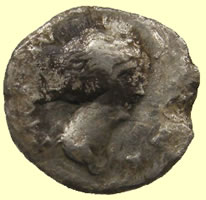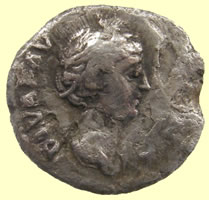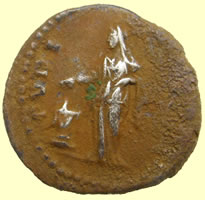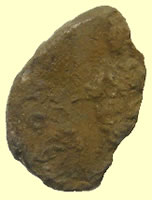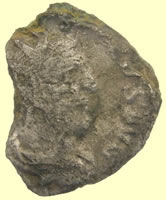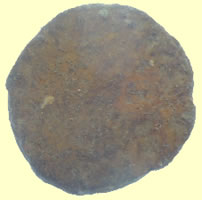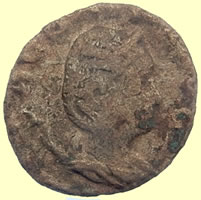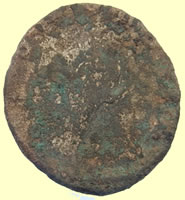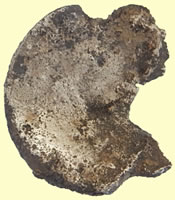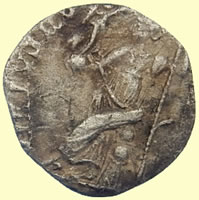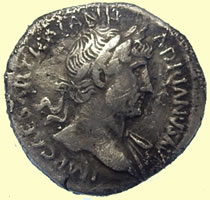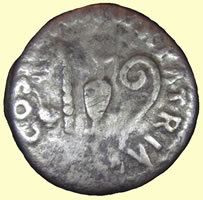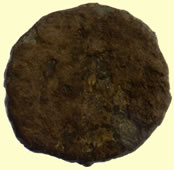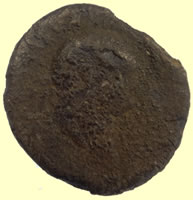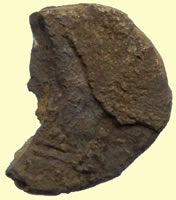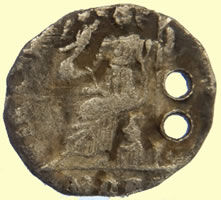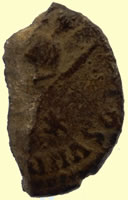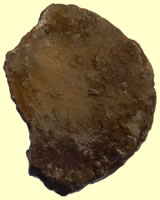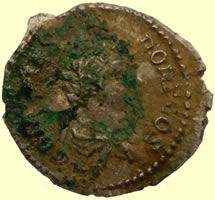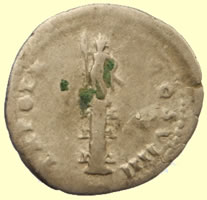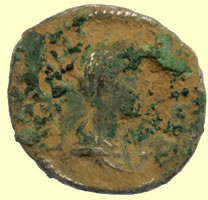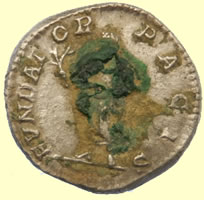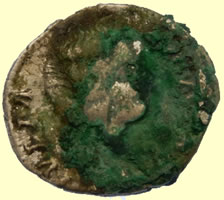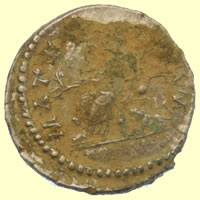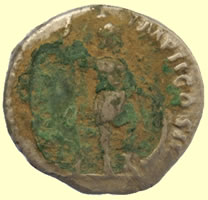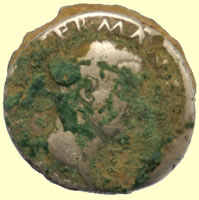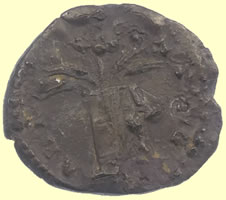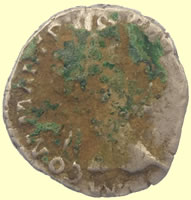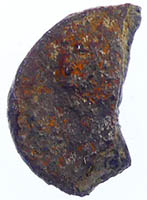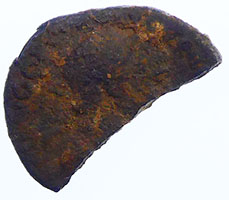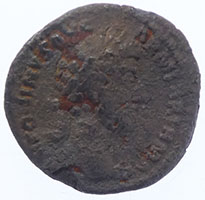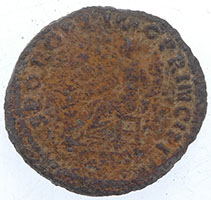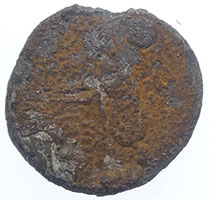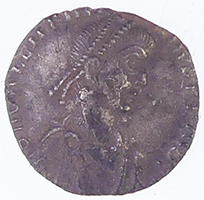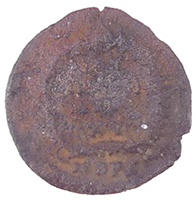

Metal detecting holidays in England with the World's most successful metal detecting club.20 years plus.
Twinned with Midwest Historical Research Society USA.
Roman silver coins from AD only BC silver Roman coins now on own page
|
|||||||||||||||||||||||||||||||||||||||||||||||||||||||||||||||||||||
For other Roman coins links For 1st to 2ndC Roman bronze coins click here For 3rd to 4thC Roman bronze coins click here All comments and ID's under the coins are from Mark Lehman our clubs Roman coin expert In 55 B.C. the Roman general Julius Caesar conquered France (At the time the country was called Gaul, and the Romans called it Gallia). The Gauls fought hard against the Romans and had been helped by their friends in Britain. Caesar was upset by their assistance and decided to teach the Britons a lesson.
Julius Caesar made two attempts to invade Britain, first in 55 B.C. and then again in 54 B.C. Both times the British warriors and the rotten British weather made his army give up and return to Gallia. Nearly a hundred years later in 43 A.D. the Emperor Claudius sent another army to invade Britain. This time the Romans were successful, Roman Britain had begun!
Comments and ID's against Roman coins are from our expert Mark Lehman who also lectures on the subject in the USA Comments and ID's against Celtic coins are from Dr Philip de Jersey who runs the National Celtic Coin Index
Roman silver Coins Denarius Quinarius
|
|||||||||||||||||||||||||||||||||||||||||||||||||||||||||||||||||||||
'The
"Aha!" moment has arrived. The coin is not of the Flavian
Dynasty after all - it's Galba - and a very rare coin! |
|||||||||||||||||||||||||||||||||||||||||||||||||||||||||||||||||||||
 |
|||||||||||||||||||||||||||||||||||||||||||||||||||||||||||||||||||||
It's a denarius of the Emperor Vespasian (69-79 AD), minted in Rome AD 75. Obverse: Reverse: Thanks to Jan de Veen of the UR forum for ID |
|||||||||||||||||||||||||||||||||||||||||||||||||||||||||||||||||||||
 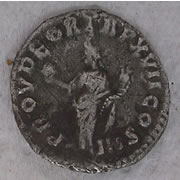 |
|||||||||||||||||||||||||||||||||||||||||||||||||||||||||||||||||||||
Beautiful Roman silver ID by Mark Lehman 2.72g, 18.19mm Marcus Aurelius in 163 A.D This one's almost too easy. This
denarius would be easily recognizeable from its realistic portrait
of the youngish Marcus Aurelius in 163 A.D. just after his elevation
from Caesar under Antoninus Pius (138-161 A.D.) to Augustus in his
own right, even if it didn't have a single letter of legend showing. This is a great example of how well-dated some Roman coins were. In the case of those emperors who didn't necessarily renew TR P, Imperium, etc, all on the same date as the commencement of their Consulships (if any), it is possible to date some coins to a frame of months or even weeks. |
|||||||||||||||||||||||||||||||||||||||||||||||||||||||||||||||||||||
  |
|||||||||||||||||||||||||||||||||||||||||||||||||||||||||||||||||||||
Silva siliqua
of Constantine III 5thC found by Texas Dave |
|||||||||||||||||||||||||||||||||||||||||||||||||||||||||||||||||||||
 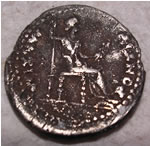 |
|||||||||||||||||||||||||||||||||||||||||||||||||||||||||||||||||||||
'That,
my friend, is a denarius of Tiberius, 14-37 A.D. Not only is it Tiberius,
but that is also the piece that is commonly referred to as "The Tribute
Penny" for being considered the most likely coin that Jesus examined
and opined: "Render unto Caesar the things that are Caesar's, and
unto God, the things that are God's" in Matthew 22, 17-21. These are in no way and by no rational definition rare - actually, they're very-to-extremely common. Tiberius was a rather uninvolved and unimaginative fellow, had very few denarius types, and struck this type throughout his long reign. - but due to the Biblical reference, these have enormous cross-over appeal to folks who would otherwise not care in the least about ancient coins, so they normally sell for several times the amount they would otherwise bring. Obv: TI CAESAR DIVI AVG F AVGVSTVS = Tiberius, Caesar, Son (adopted) of the Deified Augustus, Augustus (in his own right) Laureate head right. Rx: PONTIF MAXIM = Head of the State Religion. Livia (his mum, you might remember her and her antics from "I Claudius" a few years back on BBC) seated right, holding long, vertical scepter and branch, ornamented legs on chair, footstool, single line underneath. RIC I, 30, Mint of Lugdunum (Lyon, France), RSC 16a, SR 1763, VM 8. That's a very, very nice, well struck and centered, full VF specimen, too'. |
|||||||||||||||||||||||||||||||||||||||||||||||||||||||||||||||||||||
  |
|||||||||||||||||||||||||||||||||||||||||||||||||||||||||||||||||||||
Claudius,
49-50 A.D. and is RIC I, 49 - frequency "R4"! |
|||||||||||||||||||||||||||||||||||||||||||||||||||||||||||||||||||||
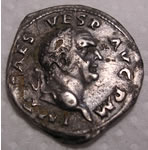  |
|||||||||||||||||||||||||||||||||||||||||||||||||||||||||||||||||||||
2.03g – 17.7mm 'obviously
don't have to tell you that this is Vespasian, but this one is so nice
and clear that I will give you chapter and verse from the standard references
- no uncertainties with this one! |
|||||||||||||||||||||||||||||||||||||||||||||||||||||||||||||||||||||
  |
|||||||||||||||||||||||||||||||||||||||||||||||||||||||||||||||||||||
4thC Roman silver RBS
ROMA / Shewolf & twins city commemorative from the mint of Lugdunum
(Lyons, France) - it would date to about 335-337 A.D. being the smaller
module issue - the larger ones (c. 18 + mm) are the ones from 'It
would have been silver-washed, originally - the alloy itself might
have contained a percent or two of silver as well, but not nearly
enough to make the coin look silvery on its own. Except for the silver
or billon argenteus of the era, there were no silver coins, per-se,
in circulation - silver-washed bronze or copper evidently filled-in
as token coinage at a good bit above its intrinsic value with the
silver wash to indicate that it took the place of silver. Unfortunately,
little to nothing survives from contemporary records and no even knows
what these were called as a denomination, or what relationship they
stood to the gold and other base denominations. Mark |
|||||||||||||||||||||||||||||||||||||||||||||||||||||||||||||||||||||
  |
|||||||||||||||||||||||||||||||||||||||||||||||||||||||||||||||||||||
'This
is an AR Siliqua of Honorius (393-423 A.D.) minted at Mediolanum, or
Milan, as we know it today, in the first few months of his reign in
393 - when he was 9 years old. RIC IX, 26, RSC 63.' 0.94g,16.71mm |
|||||||||||||||||||||||||||||||||||||||||||||||||||||||||||||||||||||
  |
|||||||||||||||||||||||||||||||||||||||||||||||||||||||||||||||||||||
Domitian
81-96 AD silver denarius 3.0g,18.83mm |
|||||||||||||||||||||||||||||||||||||||||||||||||||||||||||||||||||||
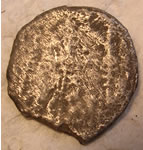 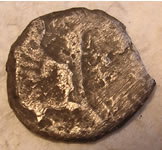 |
|||||||||||||||||||||||||||||||||||||||||||||||||||||||||||||||||||||
1.96g, 15.61mm 'That's
a "Legionary Denarius " of Marc Antony. |
|||||||||||||||||||||||||||||||||||||||||||||||||||||||||||||||||||||
Denarius of Antoninus Pius, 138-161 A.D1.82g – 16.83 mm |
|||||||||||||||||||||||||||||||||||||||||||||||||||||||||||||||||||||
Antoninianus of Postumus
'That's
an antoninianus of Postumus - emperor of the Gallic Empire of Rome.
The northern and western provinces split off on their own during the
difficult and chaotic times in the 250's & 260's A.D. About the
same time Valerian was being captured by the Persians - and subjected
to various colorful humiliations - leaving his son Gallienus in sole
charge of the empire, Postumus, who had been one of Gallienus' generals,
was proclaimed emperor by his troops and found himself in a very favorable
position of power. He therefore was the emperor of Spain, Gaul and
Britain for almost a decade. His successors did not fare as well,
and the Tetrici were eventually forced to abdicate in favor of Aurelian. |
|||||||||||||||||||||||||||||||||||||||||||||||||||||||||||||||||||||
Roman silver sent to Mark for ID 2.92g, 18.87mm Julia Domna, the wife of Septimius Severus Rome c. 196 A.D That's
Julia Domna, the wife of Septimius Severus and mother of Caracalla and
Geta. The denarius reads IVLIA AVGVSTA on the obverse and DIANA LVCIFERA
on the reverse which shows Diana standing left, crescent moon on her
shoulders, holding a long torchdiagonally with both hands. This is a
product of the mint at Rome c. 196 A.D. - during the reign of her husband.
RIC IV, I 548, RSC 27, SR ('88) 1835, VM 15. Although RIC rates it "scarce",
I don't believe it's really any scarcer than most other relatively common
types. |
|||||||||||||||||||||||||||||||||||||||||||||||||||||||||||||||||||||
Denarius of Faustina I- 147AD That's
a denarius of Faustina I, wife of Antoninus Pius whom she married during
Hadrian's time. She died in 141 A.D. after giving birth to numerous
children, including the future Faustina II, wife of Marcus Aurelius. |
|||||||||||||||||||||||||||||||||||||||||||||||||||||||||||||||||||||
  |
|||||||||||||||||||||||||||||||||||||||||||||||||||||||||||||||||||||
Roman
Denarius Augustus 27 BC - 14 AD Caius & Lucius Caesars |
|||||||||||||||||||||||||||||||||||||||||||||||||||||||||||||||||||||
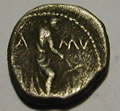  |
|||||||||||||||||||||||||||||||||||||||||||||||||||||||||||||||||||||
Very rare silver 1/4 stater Cunobelin tribe 10 to 40 AD CCI 03.0812 |
|||||||||||||||||||||||||||||||||||||||||||||||||||||||||||||||||||||
  |
|||||||||||||||||||||||||||||||||||||||||||||||||||||||||||||||||||||
117AD Roman Hadrian silver coin 'This
is an early denarius of Hadrian, 117 A.D. - his first year as emperor.
You can tell it's an early one as the portrait looks so much like Trajan. Obv: IMP CAESAR TRAIANVS HADRIANVS AVG. Laureate bust right with drapery on far shoulder. Rx: P M TR P COS DES II - CONCORD (in exergue) concordia seated left holding patera and resting arm on statuette of Spes; cornucopiae beneath throne. RIC II 17, RSC 251a, SR 3465, VM 43/1. |
|||||||||||||||||||||||||||||||||||||||||||||||||||||||||||||||||||||
  |
|||||||||||||||||||||||||||||||||||||||||||||||||||||||||||||||||||||
30AD Cunobelin Celtic silver coin
'further
to yesterday's email, yes, this is a rare silver unit of Cunobelin.
The type is in recent volumes of 'Coins of England' (no. 310) but isn't
in VA or the BMC catalogue. I've attached an image of the best of the
six we already have here for you to compare. I'll
record it as CCI 06.0523. Congratulations on a rare find!' |
|||||||||||||||||||||||||||||||||||||||||||||||||||||||||||||||||||||
    |
|||||||||||||||||||||||||||||||||||||||||||||||||||||||||||||||||||||
Despite
how badly encrusted this is, it's easily identified. It's Vespasian
- a silver denarius of course - dating to 72/3 A..D. The reverse shows a lineup of sacrificial tools and vessels symbolic of the pontificate and augurate - (simpulum, sprinkler, jug and lituus) - above them, and not really visible on yours at the moment, it should read: "AVGVR" - Below the implementia, it reads: "TRI POT" The obverse should, when cleaned, read: "IMP CAES VESP AVG PM COS IIII". Laureate head right. RIC II 42, RSC 45 |
|||||||||||||||||||||||||||||||||||||||||||||||||||||||||||||||||||||
 
'This
is a denarius of Trajan (98-117 A.D.) From the "COS V" (5th
consulship) in the reverse legend, as well as the form of the obverse
legend we can date it to the period of 103-111 A.D. Further research
and hoard evidence on the series dates this particular piece to 109
A.D. 3.04g,18.24 |
|||||||||||||||||||||||||||||||||||||||||||||||||||||||||||||||||||||
Cleaned using the oil and lemon juice 'cooked' method |
|||||||||||||||||||||||||||||||||||||||||||||||||||||||||||||||||||||
Your piece (a) isn't
quite as clear, but it's still easily recognizeable as a denarius of
Hadrian, Trajan's successor, who reigned 117-138 A.D. This is from the
enormous COS III series. Hadrian was consul only three times so almost
all the coins from the end of his period have COS III in their reverse
legends - those with only COS III as reverse legend date to 125-128
A.D. As I look at further references, I'm leaning more towards Libertas - we'll have to see whether she's holding out that right hand and if so, what's in it. 2.88g, 17.65 |
|||||||||||||||||||||||||||||||||||||||||||||||||||||||||||||||||||||
Silver Roman coin 14-37 AD 1.46g, 17.40mm It's a denarius of Tiberius, 14-37 A.D. This is virtually the only type of denarius Tiberius struck. He was not a particularly imaginative or engaged emperor, he didn't really want to be emperor to begin with, and after setting things up in Rome to run thmselves - not always wisely if you recall the story of Sejanus - he retired to his villla (and his debaucheries, if historians of the era are to be believed) on Caprea, never to return to Rome. Since the "historical" ministry and death of Jesus is traditionally said to have occurred during his reign, it is this type which is known (for no real good reason, since other types were equally as likely to have been in circulation in early 1st century Judea) as "The Tribute Penny", after the parable in Matthew. Personally, I tend to feel that this is mainly a marketing ploy to increase the selling price of a very common coin which would be a lot less expensive were it not for the Biblical hype - IOW, the ploy works, and they are very much in demand by non-collectors as well as those who do collect Roman coins.
Here's a picture of a whole one for comparison's sake:
Why this is only half a coin is perhaps more interesting. Although halved and quartered AE Asses of this era are fairly common and are to be presumed to be ad-hoc substitutes for scarcer Semes and Quadrantes as change in trade, I have seen very few denarii which seem to have been halved deliberately. Given that the halving of British pennies was so common in the medieval era - and the cross device on them was considered and used as a "cut along this line" sort of indicator, I'm not sure why Roman denarii seemed not to be cut often - perhaps it was out of respect for or a desire to avoid (and/or a law prohibiting) defacing of the all-important Imperial portrait. Quinarii (half denarii) of this era are rare to non-existent, so we must assume that Sestertii, Dupondii and Asses served normally to make change for a denarius.
I have to guess that this piece was broken in the ground rather than in circulation.
Mark |
|||||||||||||||||||||||||||||||||||||||||||||||||||||||||||||||||||||
This early Roman silver is proving to be fascinating as it 'cooks'. It is badly debased silver and laminating badly, almost like different layers of silver hammered together. I have sent it off to our Roman expert and here is his views. 'From the shape of the head (only, as that's all there is to go on at this point) this appears to be a denarius of Antoninus Pius - 138-161 A.D.
I can't tell you why it's laminating so badly - some coins do and some don't - it doesn't have the look of a contemporary copy or forgery at any rate, so far as can be ascertained in its encrusted state.'
|
|||||||||||||||||||||||||||||||||||||||||||||||||||||||||||||||||||||
This coin has been 'cooking' for several weeks now and is very slowly revealing the detail. 5thC Roman silver siliqua of Honorius The reason that this coin seems so thin is that it's the way they were made. The Romans were already (and had for some time been) experiencing the shortage of silver which would extend well into "modern" times (taking the long view) and was the reason that medieval deniers all tend to be such fish scales. This is a siliqua of Honorius. Honorius was one of the last of the Western emperors and the one during whose reign the Visigoths sacked Rome in 410 AD.
Honorius ascended to the purple at the age of 9, in 393 AD, so you know there was someone else behind the scenery pulling the strings. He was actually around for a pretty long time as rulers went (and they mostly went) in those days. He survived until 423 AD. but isn't known for much of anything except happening to be in power when Rome was invaded.
I'm not certain about the reverse type, but it's probably VIRTVS ROMANORVM and would show Roma seated left holding a small Victory and a scepter. Then looking at the image again, it might actually be a half-siliqua with the VICTORIA AVGGG reverse showing Victory walking left. A diameter measurement might help tell what it is (in addition to some further cleaning) - and there are other types it might be, too, it's just those are the most likely ones this could be based on what is visible in the photo.
Mark
|
|||||||||||||||||||||||||||||||||||||||||||||||||||||||||||||||||||||
As dug
Early Roman silver coin in the 'cooker' to remove the horn silver crust 17.87mm, 3.01g This is a Tiberius Denarius of the so-called "Tribute Penny" type - reverse is Livia (his mother, the presumed poisoner of many of the Julio-Claudians) seated right. This was virtually the only type of denarius issued by Tiberius over his long reign from 14-37 AD. You have had at least one specimen of this type before, about which I wrote at some length if I recall correctly, so I would refer you to my earlier description and explanation of the type.
Mark |
|||||||||||||||||||||||||||||||||||||||||||||||||||||||||||||||||||||
Yes, of course this is Faustina - that's pretty obvious. However there were 2 Faustinae, the wives of Antoninus Pius and Marcus Aurelius respectively. This is the 2nd, also known as "Faustina Junior". She and Marcus Aurelius were married in 145 AD. while he was still Caesar under Antoninus Pius and raised to the rank of Augusta in 147. So her coinage exists in several phases: those struck by Antoninus Pius before, then after becoming Augusta, those struck by Marcus Aurelius during her life, and those struck in her honor posthumously. she and Marcus evidently had a closer relationship than that enjoyed by most Imperial couples - Faustina accompanied or visited him throughout his military career in far-flung outposts while fighting the Germans. For this, she became known as "Matri Castrorum" - "Mother of the Camps". This piece was struck by Marcus Aurelius while she was still living, sometime between his elevation to Augustus in 161 and her death in 175. The reverse type, which is a bit hard to read in its present condition is "SALVS" - the allegorical personification of Salus ("health", but as in "the Health of the Empire" or "of the body-public", etc.) seated left feeding a serpent arising from a low altar at her feet. This is a pretty obscure reference for us at this remove in time, but it was full of important symbolism for the Romans. Whether at that point in time it was still occurring that the Vestals and/or other faithful Roman women fed actual serpents in ceremonies from which all men were banned, I don't know. Ceremonies of this type were important well into the Imperatorial era. However, the image of this ceremony remained a part of the Roman psyche and symbolized the "Purity" or "Virtue" of the Empire to the extent that it could interact with serpents and not be harmed. |
|||||||||||||||||||||||||||||||||||||||||||||||||||||||||||||||||||||
  |
|||||||||||||||||||||||||||||||||||||||||||||||||||||||||||||||||||||
Could be Annia Galeria Faustina, more familiarly referred to as Faustina the Elder (Latin: Faustina Major; born September 21 about 100, died 141), was a Roman Empress and wife of Roman Emperor Antoninus Pius. Mark |
|||||||||||||||||||||||||||||||||||||||||||||||||||||||||||||||||||||
  |
|||||||||||||||||||||||||||||||||||||||||||||||||||||||||||||||||||||
It's always hard to tell whether a half-coin was cut for change - a very common practice in the "middle ages" as you must be aware - in fact the long-cross reverse has been said to have been continued as a major reverse type for so long because of its utility in showing where to cut... or whether any particular half-coin was broken by a plow-hit, etc.
This appears to have started out as a denarius of Hadrian - one of the "grand tour" types. Hadrian toured the entire Empire towards the end of his career. He issued gold, silver and bronze to commemorate his visits to various provinces and locales. One of the most common reverse types for these coins was an allegorical personification of "The Province" or river, etc, - whichever he happened to be honoring - usually seated recumbent, legs stretched out, by the side of the local river or framed by the local landscape. I thought I had an image of a Hadrian AEGYPTVS, or NILVS, or AFRICA denarius available to show you, but I can't find one quickly.
So I can't tell which of maybe 15 or 20 locational types this is, but from the portrait, I'm pretty sure it's Hadrian - there were some similar types issued by other emperors, too, but the general type is more usually associated with Hadrian than with anyone else.
Mark
|
|||||||||||||||||||||||||||||||||||||||||||||||||||||||||||||||||||||
14.25mm, 1.32g --------------------------------------14.59mm, 1.14g Fascinating to see the two cleaned up Celtic silver coins alongside each other as they are from totally different dies but with the same design found around the same Bronze Age village site. First one is recorded as CCI 08.9325, 2nd one is 08.9326. I will send the new cleaned up pictures to Dr Philip for his further comments. The two Cunobelin silvers are very nice, and a rare type at that. The first one (West side of the Bronze Age village) will be 08.9325, and logically enough today's will be 08.9326. They are both the same type, I think - the seated figure is to the left on the second one. The only standard reference for the type is no. 308 in Spink's Coins of England, it's not in Van Arsdell or the BM catalogue. On the first one of the two you can see the amphora which the seated figure is holding quite clearly, but the CVNOBE doesn't show up too well on either. I don't have the exact figures here for rarity, but I don't think there are more than a dozen of these recorded at most. Date is perhaps somewhere in the middle of Cunobelin's reign, say perhaps c. 20-25 AD.
|
|||||||||||||||||||||||||||||||||||||||||||||||||||||||||||||||||||||
|
|||||||||||||||||||||||||||||||||||||||||||||||||||||||||||||||||||||
Yes, you are becoming quite expert in getting encrusted early silver looking presentable again. This is Tiberius and the coin is the so-called "tribute penny" denarius which is often associated with the passage in Matthew about "rendering unto Caesar.." etc. This has been a very successful marketing ploy and results in this type generally bringing a price far above what it should, based on its scarcity (or lack thereof).
Tiberius was a rather reluctant "heir" to the Principiate to begin with and made a distant and barely-concerned emperor. After his first few years in office, he retired to his huge villa on the Island of Caprae and never set foot in Rome again. He cared so little that he never bothered to change the types of the coins to take advantage of their great propaganda value in a time and place in which they were nearly the sole mass media. So, from 14-37 AD - a rather long rule - he continued to produce the same few types - and only this one type of denarius.
Mark |
|||||||||||||||||||||||||||||||||||||||||||||||||||||||||||||||||||||
|
27AD silver Divus Argusta |
|||||||||||||||||||||||||||||||||||||||||||||||||||||||||||||||||||||
  |
|||||||||||||||||||||||||||||||||||||||||||||||||||||||||||||||||||||
2ndC Roman silver coin sent off for ID 17.05mm, 2.79g Mark Lehman just sent me this feedback & ID on the coin
The denarius is from Antoninus Pius, who, as you're probably aware, built a second, more northerly wall between Britain and the "barbarian north" - although of earth rather than stone and, I assume, not nearly so well appointed by way of amenities for its garrisons.
This piece is dated by the obverse and reverse legends to December 10, 159 - December 9,160 AD. Minted in Rome - the obverse should read: ANTONINVS AVG PIVS P P TR P XXIII.
The reverse shows Antoninus, togate, sacrificing at a tripod altar and holding a scroll - it reads VOTA SVSCEP DECENN III COS IIII
RIC III 306, RSC 1113.
This reverse commemorates his completion of his 2nd Decennalia and states that he has undertaken the vows for his 3rd as the Pontifex Maximus of the State religion. At various intervals, usually 5's and/or 10's of years within the reign, the emperor performed ceremonies in thanks for his successful reign and pledging to make similar sacrifices if the gods give him another 5 or 10 years of "success". Although in later years, emperors tended to "anticipate" these ceremonies - sometimes by many years - and they cease to be an accurate dating feature, in the 2nd century, this ceremony would have been on the 20th anniversary of his ascension on July 10, 138 and been a pretty big official celebration. This coin, then, is repeating the "news" of him having celebrated his 2nd Decennalia the previous year, and having made his vows for the 3rd, which he would not live to see, dying at Lorium, March 7, 161.
Many consider the reign of Antoninus as the true "Golden Age of Rome" - the apex of Roman power and civilization. Although the allegorical personification of Britannia was first introduced by Hadrian as a reverse type for sestertii of his "Grand Tour" series, the Britannia seated on a rock reverse which would be adapted for use on pennies and half-pennies in the 18th-20th centuries, was the reverse type on a very large emission of Antoninus' copper asses minted "in the field" in Britain during his reign.
Mark
|
|||||||||||||||||||||||||||||||||||||||||||||||||||||||||||||||||||||
  |
|||||||||||||||||||||||||||||||||||||||||||||||||||||||||||||||||||||
Under closer examination and tweaking the images a little, I'm pretty sure this piece at least began its career as a half-siliqua of Arcadius, 383-408 AD. If I am reading the lower letter-seriphs on the obverse correctly, what's visible should, I believe, read "D N ARCADI [ VS P F AVG]" - the legend breaking between I - V is correct for Arcadius too.
Interestingly - and I'm not sure whether this "proves" anything or not, I also have a siliqua of Arcadius showing some clipping and which also weighs exactly 0.7gm http://www.stoa.org/gallery/album83/02_Arcadius_Sil_MIL - this complicates the issue a little, since I can't see any features on the reverse of your coin which would indicate either Roma seated left (legend: VIRTVS ROMANORVM or VRBS ROMA) or a "Vota" type with vows: VOT / X / MVLT / XX in a wreath - which are the only 2 reverse types for Arcadius' siliquae - but that piece from my collection might also be a siliqua officially clipped-down to sceat-size. Certainly to make a sceat out of a half-siliqua would require the removal of a lot less metal - or your piece might merely be a skimpy, underweight half-siliqua with no clipping.
However, the reverse of yours I cannot be quite as certain about as the obverse, but I believe it is VICTORIA AVGG (or AVGGG, depending on the era - 2 emperors before, or 3 after the ascension of Theodosius II in 402) with Victory advancing left holding wreath and palm. I believe I can see [VI] CTOR [IA AVGG(G?)] between 9:00 - 11:00. The crook-like feature at the top-right should be Victory's arm holding up a wreath at about 12:00. Although these are AE denominations and some years earlier, the general design of the reverse should be the same or similar as one or the other of these two: http://www.stoa.org/gallery/album82/09_Valentinian_I_SER_ALE or http://www.stoa.org/gallery/album82/37_Valentinian_II_VIA_SIS
I can't make out anything at all for a mint mark, so I can't tell you the city of origin with certainty, but it appears that Arcadius struck half-siliquae only at Milan (MD in exergue) Aquilea (AQPS in exergue) or Rome (RM in exergue). In case you can make out letters at the bottom, that's the list of probable exergual mint marks to look for on a half-siliqua of Arcadius.
Good digging this season!
It's encouraging that your first Roman is an interesting AR instead of an AE grot for a change!
Mark |
|||||||||||||||||||||||||||||||||||||||||||||||||||||||||||||||||||||
 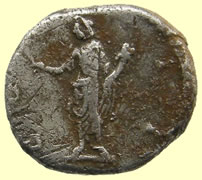 |
|||||||||||||||||||||||||||||||||||||||||||||||||||||||||||||||||||||
Roman silver coin send for ID This is a denarius of Marcus Aurelius as Caesar under Antoninus Pius. Do you notice you've been finding a LOT of Antonine-era and Constantinian-era material - and very little Severan or late 3rd century material? It seems this site must have had a couple of population or activity peaks - one in the mid 2nd century and one in the early-mid 4th century. There seems to be a gap - at least in the coins you're finding - of a century and a half to two centuries. That's if this all has been coming from the same site, of course.
The obverse legend is AVRELIVS CAESAR AVG PII F, M. Aurelius' bare head right. The reverse reads (I believe) COS II - meaning that he's now in the office of consul (sort of like "President" or "Prime Minister") for the second time - since all we can see is "CO...II" it might also be COS DES II meaning elected but not yet inaugurated - making a difference of a couple months and placing it in the previous year (144.) The device is Honos standing left holding a branch and a cornucopia - this type is known for both COS II & COS DES II. As far as I can tell, this is a product of the mint at Rome in AD 145 (but maybe 144).
Mark
|
|||||||||||||||||||||||||||||||||||||||||||||||||||||||||||||||||||||
 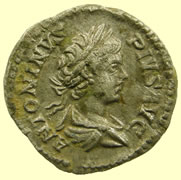 |
|||||||||||||||||||||||||||||||||||||||||||||||||||||||||||||||||||||
Best condition 2nd C Roman silver coin I have seen dug - sent for ID 2.89g, 18.95mm Of course, just as soon as I comment that you never seem to find any Severan Dynasty material, the very next coin you send me is right in the thick of the Severan Era. This denarius is of Caracalla - as a young man, obviously - he was elevated to the status of co-emperor alongside his father, Septimius Severus, at about the age of 10 in 198. This denarius, from the main mint at Rome, was struck c.203. The reverse type, VIRTUS AVGG, has Virtus (or Roma - it's somewhat ambiguous who was intended) standing left holding a small image of Victory and a spear.
(RIC IV 149, RSC 665a, SR 6903)
As for the condition - sure, I suppose it might have been in a pot which has only be broken open by agricultural action in very recent times. This is relatively good silver (maybe 50-60% or better) so would be far less liable to corrosion than silver heavily alloyed with copper and/or lead.
Quite the decent piece - not particularly scarce as these go, but a great find for you and your coin-shooters.
Mark
|
|||||||||||||||||||||||||||||||||||||||||||||||||||||||||||||||||||||
  |
|||||||||||||||||||||||||||||||||||||||||||||||||||||||||||||||||||||
  |
|||||||||||||||||||||||||||||||||||||||||||||||||||||||||||||||||||||
Roman silver coin with green crust - cooking it to remove crud - sent for ID 16.23mm, 2.95g it's a denarius of Julia Domna, on whom I gave you a lot of background earlier today. Wife of Septimius Severus, etc. I believe, although it's difficult to be sure given the condition, that the reverse type is VENVS VICTRIX - which is a fairly common reverse type for Domna.
Mark
|
|||||||||||||||||||||||||||||||||||||||||||||||||||||||||||||||||||||
 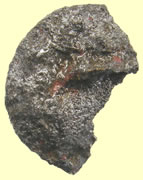 |
|||||||||||||||||||||||||||||||||||||||||||||||||||||||||||||||||||||
Roman silver coin forgery - you can see clearly the copper core has seeped through
Although "fourree" silver-over-copper denarii are not terribly uncommon, they tend to be seen more in the Republic and early Imperial era, however. Those silver foil-wrapped copper cores, the foil sealed to the core with flux and the whole package struck with dies was the "standard" for counterfeits - ie: fakes made to deceive and pass current as good silver denarii for a long time. |
|||||||||||||||||||||||||||||||||||||||||||||||||||||||||||||||||||||
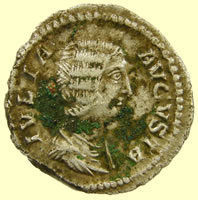  |
|||||||||||||||||||||||||||||||||||||||||||||||||||||||||||||||||||||
Another silver Roman with green grunge' growing on it - sent for ID 18.65mm, 2.57g Yes indeed - if they all came out of the ground looking like this, you wouldn't have much use for me! This is, of course, Julia Domna, wife of Septimius Severus, mother of Caracalla & Geta, great-aunt of Elagabalus & Severus Alexander. Septimius Severus married her in 188 because of a fortuneteller's prediction that she would be an empress - and so she was, in fairly short order, Severus donning the purple on the downfall of Didius Julianus in 193.
It wasn't all roses and luxury, however, she accompanied her husband all around the Roman world during the last 5 years of his military career, and her younger son, Geta, was murdered before her eyes and died in her arms after being tricked by older brother Caracalla into attending a banquet at which they were supposed to renounce their earlier antagonism and share the empire between them as Dad Severus had intended before his death at York in 211 - Julia accompanied him on this campaign, as did Caracalla.
She outlived her family (not all that unusual for Imperial women), but not for long, committing suicide by self-starvation in late 217. Coins were struck in her honor under both Septimius and Caracalla and she was the first woman to be portrayed on Caracalla's new denomination, the antoninianus or double denarius.
This is a denarius, of course, and the reverse type is the simple IVNO - (Domna as) Juno holding a patera to feed a peacock - which isn't quite visible behind the green encrustation to her left - and a scepter. This type, struck under Septimius Severus, dates about 209 AD, and is considered common - although the condition of this specimen is anything but common for your area - the denarii were still relatively good silver at this time, however, and had a lot less base metal in the alloy to corrode and degrade.
RIC 559, RSC 82, SR 6588.
Mark
|
|||||||||||||||||||||||||||||||||||||||||||||||||||||||||||||||||||||
    |
|||||||||||||||||||||||||||||||||||||||||||||||||||||||||||||||||||||
Cooked Roman silver sent for ID 1.43g, 17.71mm This is a denarius (well, most of one anyway) of Antoninus Pius - 138-161 AD. The reverse type is a bit more difficult to tell since the really interesting bit is almost completely off the coin. It's Salus, the personification of the soundness or "health" of the Empire standing left and feeding from a patera a serpent arising from the short altar at her feet. You can just see the tip of its head at the end of her arm and you can see a loop & coil of body hanging off the altar if you know what you're looking at.
The reverse legend would be COS IIII which doesn't tell us a whole lot except that this coin was struck during or after his 4th consulship - 145-161, but add to the calculations the TR P date of XI from the obverse legend and we can date it to 147/8 AD.
Mark
|
|||||||||||||||||||||||||||||||||||||||||||||||||||||||||||||||||||||
As dug and partially 'cooked'
Almost 'cooked' , below is Mark Lehman's initial ID, I have resent it to him now I have 'cooked' it better You seem to be getting a lot of unintended small change lately - This is a denarius of Severus Alexander - the last member of the Severan Dynasty, 222-235 AD. This one should read: IMP C M AVR SEV ALEXAND AVG on the obverse and ANNONA AVG on the reverse. In addition to the missing parts, there seems to be either a squashed letter "A" or a letter "I" in error at the end of ANNONA. Annona was the allegorical personification of the grain supply - yes, it was THAT important to the Romans so that it required a minor deity to be "in charge" of imported grain. She's shown holding a handful of grain-ears and a cornucopia. What I can't tell is whether she has her foot on a ship's prow or there's a modius - a grain-measure basket - at her feet since that bit is missing. If it's the ship's prow, this coin dates to 228 - if it's the modius, it's 226. For our purposes, we can assume that all the silver was struck at the mint in Rome at this point in time.
|
|||||||||||||||||||||||||||||||||||||||||||||||||||||||||||||||||||||
|
|||||||||||||||||||||||||||||||||||||||||||||||||||||||||||||||||||||
  |
|||||||||||||||||||||||||||||||||||||||||||||||||||||||||||||||||||||
Roman silver coin sent for ID 1.85g, 19.11mm This is our old friend Tiberius - again! - it's the ever-popular, so-called "Tribute Penny" of which you seem to find many. There probably were plenty of them still in circulation at the time of Claudius' invasion. Tiberius for all practical purposes only struck this one type of denarius throughout his long (14-37 AD) reign. If it were not for the (somewhat dubious) "biblical reference" which causes this coin-type to be of interest to non-numismatic folks who want it for its supposed biblical link, it would be, rather than one of the most desireable and expensive, one of the cheapest and most common 1st century denarii.
Mark
|
|||||||||||||||||||||||||||||||||||||||||||||||||||||||||||||||||||||
Roman 1st/2nd C silver coin as dug and 'cooking' to remove crust |
|||||||||||||||||||||||||||||||||||||||||||||||||||||||||||||||||||||
Sent to Mark for provisional ID - still cooking it some more 2.84g,17.09mm You probably won't be surprised that I'm not 100% certain on this one, but the obverse looks very like Vitellius - one of the 4 contestants for Nero's throne in 68 AD. Aside from Vespasian - who was the eventual victor - they're all scarce to rare. Vitellius is probably the least rare of the less common three (Galba, Otho & Vitellius), but it's still pretty unusual to encounter one of his denarii.
If I could just get some idea of what was supposed to be happening on the reverse in order that I could confirm that it's among Vitellius' reverse types, I'd probably be pretty certain, but I can't quite figure out what is going on with the reverse.
Mark |
|||||||||||||||||||||||||||||||||||||||||||||||||||||||||||||||||||||
  |
|||||||||||||||||||||||||||||||||||||||||||||||||||||||||||||||||||||
Best condition Roman silver I have ever seen dug- next to fresh water spring ! Probably an offering Sent off for ID 16.3mm,3.39g This is a denarius of Antoninus Pius, 138-161- there are many who consider his reign the height of the golden era of Imperial Rome. There was so little strife, war, plague or disaster that the result is that there's very little written about him or his times other than "He was known as the fairest and wisest of rulers and blah..." Of course from the British perspective, he's important for having built the second wall, north of Hadrian's. From the dates which are parts of his titles in the legends, this coin dates to 153/4. The reverse shows Vesta, the special deity of the Roman hearth and home standing left holding a simpulum - a ceremonial ladle which was part of the set of priestly implements portrayals of the set of which were an emblem of the priestly colleges, and the Palladium, sort of a short, thick scepter with a figure of Pallas/Athena at its end. Supposedly brought to Rome out of the ruin of Troy by Aeneas, it was considered a special symbol of the city's - and by extention, the empire's - devine protection.
Mark |
|||||||||||||||||||||||||||||||||||||||||||||||||||||||||||||||||||||
Roman silver coin sent off for IDAntoninus Pius (138-161) 2.92g, 17.49mm The denarius seems to be Antoninus Pius (138-161), I'm not certain about the reverse type yet, but it might be a Fortuna type, I seem to make out "FORTVNA" on the left. Antoninus was a prolific producer of types, we'll need to be able to read at least a few letters of the legend on the reverse to be more sure. |
|||||||||||||||||||||||||||||||||||||||||||||||||||||||||||||||||||||
 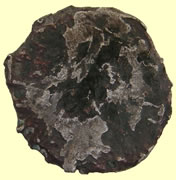 |
|||||||||||||||||||||||||||||||||||||||||||||||||||||||||||||||||||||
Interesting Roman silver forgery sent for ID 2.36g, 17.33mm This one's a bit unusual. Although "fourree" silver-over-copper denarii are not terribly uncommon, they tend to be seen more in the Republic and early Imperial era, however. Those silver foil-wrapped copper cores, the foil sealed to the core with flux and the whole package struck with dies was the "standard" for counterfeits - ie: fakes made to deceive and pass current as good silver denarii for a long time.
This piece has the portrait of Geta on it, and the legend for Geta as Caesar dates it (or its prototype) to 198-209 AD. By this time, the official denarii were hardly more than 50% silver, so there was very little profit to be made by creating traditional foil-wrapped, copper coins. This piece, as you see, has more of the appearance of a very thin tissue of "silvering" on the core - and as such, copies like these predate the official silvering of antoniniani by at least 50 years, although they look like they may have been produced the same way. A very low-fineness billon blank is "pickled" in an acidic bath - lees of wine works so well it's still used for bleaching silver - this erodes the copper out of the alloy in a thin layer on the surface, leaving that surface "enriched" with silver. Then when the blank is struck, the silver on the surface spreads out into a smooth fabric which resembles modern silver plating.
This is how the silvered antoniniani of the later Empire - 265-295 were most likely produced - as well as the silvered folles and other token coins of the later Empire.
These "plated" or "silvered" denarii are found now in relatively great numbers in Eastern Europe - Bulgaria, Romania, the former Yugoslavian states etc - they used to be somewhat of a curiosity and were not seen very often but now are becomming commonly known, overall, since they often appear in lots of Balkan-dug uncleaned coins.
So it begs the question, why were all these unofficial coins produced? We know they're not official because none of them is a die match for any known official denarii, except those obviously made by casting in molds made by impressing official coins in clay, etc. These plated pieces would have been unlikely to fool anyone into thinking they were official.
There are, of course, many theories and little or no proof. Perhaps like the limes falsa copies of Imperial AE's of the 1st century made in Britain and northern Gaul, they were a product of neighboring peoples who had become Romanized to the extent of using coins in commerce, but weren't well enough within the sphere of Roman influence to have adequate quantities of official coins. Perhaps they were a form of military scrip - paid to troops in the field and meant to be exchanged for good coin at a later date - meant to keep the "enemy" from capturing large amounts of legal tender in the event of a catastrophic defeat. Or maybe they served a purpose like plantation chits on large latifundia - farms so large that they had their own internal economies, but having a reason not to want to put hard coin in the hands of slaves who might be at risk of escape.
Lots of theories - no real proof, though.
I can't quite make out the reverse type - I believe your photo is almost upside down, being about 150º counterclockwise of its proper orientation. It seems to be a standing figure - but much more than that I can't say. These copies often have unlikely, muled combinations of obverse and reverse which don't belong together at any rate.
The Severan denarii often had similar togate figures - often the emperor or Ceasar or other member of the Imperial family standing left sacrificing at a little altar - I'm guessing this reverse might have been one of those.
Mark
|
|||||||||||||||||||||||||||||||||||||||||||||||||||||||||||||||||||||
 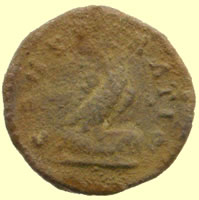  
2ndC Roman silver coin as dug and partially 'cooked' to reveal some of the detail 3.14g, 19mm The Denarius is a poshumous commemorative issue in remembrance of Antoninus Pius, by Marcus Aurelius, c. 161, AD. "DIVVS ANTONINVS / CONSECRATIO"; eagle on garlanded altar. Mark |
|||||||||||||||||||||||||||||||||||||||||||||||||||||||||||||||||||||
|
|||||||||||||||||||||||||||||||||||||||||||||||||||||||||||||||||||||
Roman silver coin - as dug and partially cooked - back in the 'cooker' to remove crust It's posthumous commemorative for Marcus Aurelius issued under Commodus c. 181-2 AD.
I know it's not easy to see yet, but the reverse is an eagle, standing left with wings open and head turned to the right - ie, you have the photo almost exactly upside-down here.
I think the reverse of the Antoninus Pius denarius was similar, although the exact attitude of the eagle may be different.
Although the eagle is facing the opposite way, this is a sestertius from that same series in memory of M. Aurelius http://www.stoa.org/gallery/album94/ML14_M_Aurel_Divus_Sest in fact it is exactly the same type, except for the direction the eagle faces.
Mark
|
|||||||||||||||||||||||||||||||||||||||||||||||||||||||||||||||||||||
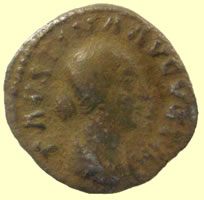    |
|||||||||||||||||||||||||||||||||||||||||||||||||||||||||||||||||||||
As dug and 'cooked' This is Faustina Junior (or "II", or "the Younger" - different sources title her differently). She was the daughter of Antoninus Pius and Faustina Senior and marrried Marcus Aurelius, Antoninus' adopted son and chosen successor soon after he was made Caesar, in 146 AD. and predeceased him by a few years in 175. Therefore, you have 3 separate "sources" of coinage for her. The first group of issues was authorized by Antoninus Pius and is thought to date to the period soon after her elevation to Augusta in 147. Marcus Aurelius issued coins in her honor after Antoninus' death as well as a large posthumous coinage towards the end of his reign. |
|||||||||||||||||||||||||||||||||||||||||||||||||||||||||||||||||||||
    |
|||||||||||||||||||||||||||||||||||||||||||||||||||||||||||||||||||||
As dug and 'cooking' Roman silver coin straight into the 'cooker' - sent for ID Very rare find Of course I can't be certain in its present state of encrustation, but it appears you have found another Galba - one of the 3 very short-lived rulers in the chaotic year between Nero's suicide and the eventual triumph of Vespasian. Although Galba's coins are the more common of the three by a significant margin (Otho & Vitellius are far scarcer) having ruled the longest during that time, they're still not at all common compared to any other of the 1st century rulers' coins.
I'll be curious to see if my initial impressions were correct, but this appears to be a Galba Denarius with a ROMA RENAS[CENS] or ROMA VICTRIX reverse - and the coin, overall, appears to be in stunningly nice condition for a farm surface find.
You keep turning up coins of this quality and scarcity, I'm going to have to come over there and dig some, myself!
Mark
|
|||||||||||||||||||||||||||||||||||||||||||||||||||||||||||||||||||||
|
|||||||||||||||||||||||||||||||||||||||||||||||||||||||||||||||||||||
|
|||||||||||||||||||||||||||||||||||||||||||||||||||||||||||||||||||||
    |
|||||||||||||||||||||||||||||||||||||||||||||||||||||||||||||||||||||
1stC Roman silver coin sent for the ID- in the 'cooker' to remove crust - As dug and 'cooked' pictures As you have probably figured by the unmistakable bowling-ball shape of his head, this is Trajan - Hadrian's immediate predecessor, 98-117 AD. I believe the obverse legend reads IMP TRAIANO AVG GER DAC P M TR P COS VI P P - a bit more cleaning will reveal whether I've got that correct or not - there are several minor differences possible in the obverse legend which would affect the date by a few years. The reverse is less of an issue - that's definitely S P Q R OPTIMO PRINCIPI, it shows Mars striding right holding a transverse spear and carrying a trophy over his shoulder. If I have the obverse legend correct, this coin dates to around 113-14 AD. RIC 270, RSC 372.
Mark
|
|||||||||||||||||||||||||||||||||||||||||||||||||||||||||||||||||||||
Debased Roman silver coin - 'cooking' to remove green crust - Turned out to be a silver washed Roman - sent for ID Not too much for me to go on - What I can say with certainty is that i'ts an antoninianus, and silvered antoniniani date to the period between 265-290 AD.
I suspect, although/because the portrait doesn't look much like him, that this is an early issue by Aurelian (270-275) - He instituted a reform in the coinage which made the coins larger and generally of better workmanship with better silvering.
All I can make of the reverse type, by placing the long line at the bottom as a "ground-line" is that the "V" shaped object at the left on the ground looks like a bent-over captive on which Aurelian might be stepping. IF that's what it is, then this would be likely to be one of the myriad of varieties of the ORIENS AVG type showing Sol right or left, standing or walking, with 3, 2, 1 or no captives, etc.
Here's an ORIENS AVG with a somewhat similar reverse to what I think I'm seeing on this coin.
also:
Mark
|
|||||||||||||||||||||||||||||||||||||||||||||||||||||||||||||||||||||
Finished 'cooked' pictures of a 4thC House of Constantine Roman silver coin |
|||||||||||||||||||||||||||||||||||||||||||||||||||||||||||||||||||||
He is the very last of the Constantinians, Julian "The Apostate" - or "The Philosopher", depending on your point of view - the budding, new Christian Church definitely favored the former since he is probably best known for trying to revive the virtues which existed in Pagan times.
His story is not altogether unlike that of Claudius. A "minor" family member, he was always in the background eclipsed by his more famous cousins, the sons of Constantine the Great. He became Caesar almost solely in name alone in 333. Assigned the administration of the less glamorous Western segment of the Empire, he managed to survive the "purge" of competing family members immediately after Constantine's death in 337 in which his cousins Delmatius and Hannaballianus (among others) were conveniently dispatched and removed from the competition.
He took advantage of the opportunities his position afforded to both educate himself and to become proficient in the arts of war and command, and by not picking any fights - fighting only when it was necessary - he managed to outlive them all. He was proclaimed Emperor by his troops in 360 which brought him into conflict with his cousin Constantius II.
On the eve of battle in this conflict, in which he was badly outmatched and expected to be defeated, he received a summons to parley. Expecting to be taken prisoner and/or murdered, as it turned out, Constantius had died during the previous night and he was instead informed that he was now the uncontested emperor of all of the Roman Empire in 361 AD.
His Imperium was a short one, however, and he lived only another 2 years, dying in a battle with the Sasanid Persians - although his rule was remembered as particularly just and even-handed.
This piece is from his short tenure as Augustus. It's a Siliqua, a denomination introduced in the reforms of Constantine - the first circulating piece in good silver the Roman Empire had seen since the early-mid 3rd century. It appears to be from the mint at Arles, due to the eagle in the medallion at the top of the wreath which was only done in Arles, but the mintmark should be PCONST (P, S or T for the officina designation preceding the CONST - for Constantiniana, the name of Arles at this time), but for some reason, yours doesn't seem to have the officina mark. I'll see if I can find out whether this is a known variation or not.
|
|||||||||||||||||||||||||||||||||||||||||||||||||||||||||||||||||||||
Debased Roman silver coin - straight into the 'cooker' - as cooked
4thC Roman silver coin sent for ID 16.92mm,1.16g 4thC Roman silver coin sent for ID 16.92mm,1.16g This is a Denarius of Elagabalus - 218-222 AD. As such it's hardly the most debased of Roman silver - it was still at least in the vicinity of 50% fine. Even though you can barely make out the reverse type, I happened to recognize Victory floating between a pair of shields - looking rather like an anachronistic segue - I have a specimen of the same type. Unfortunately this one's reverse was struck from badly worn dies, but you can see what's going on. http://www.ancientpeddler.com/apgallery/displayimage.php?album=358&pos=28 His official title/name was Marcus Aurelius Antoninus Pius (as was Caracalla's). This causes a lot of confusion among those not in-the-know and I regularly see coins of Elagabalus and Caracalla mis-identified as Antoninus Pius (138-161 AD. - I recently picked-up an incredible deal on a rare silver antoninianus of Caracalla which had been misidentified as a denarius of Antoninus Pius) The Severan Dynasty declared themselved "adopted posthumously" by Antoninus Pius and Marcus Aurelius - neither of whom was in any position to object, both having been dead for dec
|
|||||||||||||||||||||||||||||||||||||||||||||||||||||||||||||||||||||
Roman silver coin sent for ID 19.39mm dia x 1.69mm thick,3.53g
This appears at first glance to be a normal denarius of Tiberius - the common type, struck continuously throughout his reign from 12-37 AD. As you're probably aware, denarii of this type have for years been successfully marketed as the so-called "Tribute Penny", in reference to the passage in Matthew. Since I've commented several times on the likelihood (or lack thereof) of this coin being in normal circulation in Judaea c 25-30 AD, I won't belabor the point. Folks may believe what they want to believe - they will regardless. Did you do the straightening? Whoever did it was lucky, since the silver shows significant crystallization and it appears that it could have broken in the process very easily (and may yet) to judge by the surface fracturing along the bend-axis on the reverse.
This piece is unusual mostly because the workmanship is so crude, relatively speaking.
At this point, I was going to include a link to a more typical piece of this type, but my website's server appears to be down at the moment.
You describe it as "thick". The weight, however, although at the higher end of the range, is within normal variation for these. My guess is that this might be an ancient counterfeit - made to deceive, IOW, rather than the sort of officially sanctioned copies represented by the contemporary copy radiates. It's possible that it was struck in a somewhat less fine silver by someone who had the skills necessary to create believable dies - or who was in league with someone skilled. However, I'm basing this guess primarily on the appearance of the lettering - which is blobby and uneven. It's also possible that it's just a usual official piefce and is the product of "Friday afternoon workmanship" on the legends, since the main devices are relatively well - if a bit coarsely - executed.
Mark
|
|||||||||||||||||||||||||||||||||||||||||||||||||||||||||||||||||||||
2ndC Roman silver sent for ID this is a posthumous commemorative denarius of Faustina Sr., wife of Antoninus Pius, mother of Faustina Jr who was the wife of Marcus Aurelius, and so both Aurelius' mother-in-law and grandmother of emperor-to-be Commodus. Not all the Faustina coins are quite so simple - Faustina Jr. had separate lifetime issues by Antoninus Pius and Marcus Aurelius, and posthumous issues by Marcus Aurelius. Faustina Sr.'s coins, however, can be divided into two main groups - Lifetime and Posthumous. She died in AD 141, but the majority of her posthumous coins were issued after 147. At this time, her daughter was made Augusta and that title was dropped from her name on posthumous issues. It's thought that the greater number of her posthumous coins as deified (DIVA) were issued around the 10th & 15th anniversaries of her death (151 & 156 AD), but since there is no clear succession of types to assist in dating, most references merely say "post 147 AD."
This reverse is inscribed AVGVSTA and shows Ceres holding a torch. There is a large series of AVGVSTA reverses. Ceres, along with Juno, Vesta and Venus are the most commonly seen characters on the reverses of her posthumous coinage.
Mark
|
|||||||||||||||||||||||||||||||||||||||||||||||||||||||||||||||||||||
BC Roman republican silver coin sent for ID You have been finding all sorts of historically important material, lately! Julius Caesar the other day and today, it's Lucius Cornelius Sulla. If you recall any of your Roman History, Sulla's name should be nearly as familiar as Caesar's - or at least as familiar as Gaius Marius'. He was one of the "pioneers" foreshadowing the final end of the Republic and the rise of Imperium in its place.
This coin was issued while he was still in the East, fighting Mithradates VI "The Great" all over Asia minor, and finally defeating him. He refers to himself as "Imperator" (for the 2nd time, no less) with no mention of Senatorial authorization of his de-facto dictatorship and his therefore independent actions as an autonomous power with "his own" army.
This piece is cataloged as RSC/Babelon Cornelia 29 (or 30, the very minor difference in inscription is off-flan here so it doesn't really matter). This dates to 84-3 BC. It's very interesting that this Eastern military issue should turn up in Britain - this seems to be about the farthest afield we've been able to determine an origin for Roman material found in your area.
L. Cornelius Sulla, 84-83 BC
Obv: Diademed head of Venus right; Cupid holding palm-branch before; L • SVLLA below.
Rx: Jug & Lituus between two trophies; IMPER above, ITERVM (or ITERV) below
RSC Cornelia 29-30, RRC 359/2, CRR 761 SR 276.
Mark
|
|||||||||||||||||||||||||||||||||||||||||||||||||||||||||||||||||||||
As dug and cooked Roman silver coin - sent to Mark for ID I don't know if you've gotten this piece cleaned any better than the original photos showed, but in a slow moment, I enlarged the photos and compared what I could see with some common types for Septimius Severus, and I think I can now tell what it is based on the ghost of a reverse type and the fragments of lettering which show through the crust and around the edges.
I think the oberse legend is going to turn out to be: L SEPT SEV PERT AVG IMP VIII - and the reverse will be ARAB ADIAB COS II P P. Victory advancing left holding wreath and trophy. This type commemorates victories wonv in the far east, against Parthia, et als.
All the letter-seriphs that are visible on both sides seem to line up with these legends. If I'm correct, it dates to 196 AD.
I'll still be curious to see what you come up with after you cook it a bit.
Mark
|
|||||||||||||||||||||||||||||||||||||||||||||||||||||||||||||||||||||
As dug and cooked 1stC Roman silver coin sent for the ID This is a denarius of Trajan - (did you show me this one in as-dug condition?) and there's enough clean detail now to tell you that it's "Genius" (the inspirational spirit of the Roman People, not necessarily "genius" as in Einstein) holding a patera - which is sort of a saucer-like affair from which ritual libations were poured - and a bunch of corn-ears. Although the legends are different, the types are all the same as on this piece:
It's from the mint at Rome and dates to around 107 AD, or right in the middle of Trajan's reign.
Mark
|
|||||||||||||||||||||||||||||||||||||||||||||||||||||||||||||||||||||
1stC Roman silver coin sent for the ID- in the 'cooker' to remove crust - As dug and 'cooked' pictures As you have probably figured by the unmistakable bowling-ball shape of his head, this is Trajan - Hadrian's immediate predecesor, 98-117 AD. I believe the obverse legend reads IMP TRAIANO AVG GER DAC P M TR P COS VI P P - a bit more cleaning will reveal whether I've got that correct or not - there are several minor differences possible in the obverse legend which would affect the date by a few years. The reverse is less of an issue - that's definitely S P Q R OPTIMO PRINCIPI, it shows Mars striding right holding a transverse spear and carrying a trophy over his shoulder. If I have the obverse legend correct, this coin dates to around 113-14 AD. RIC 270, RSC 372.
Mark
|
|||||||||||||||||||||||||||||||||||||||||||||||||||||||||||||||||||||
|
|||||||||||||||||||||||||||||||||||||||||||||||||||||||||||||||||||||
|
|||||||||||||||||||||||||||||||||||||||||||||||||||||||||||||||||||||
  |
|||||||||||||||||||||||||||||||||||||||||||||||||||||||||||||||||||||
'Cooked' Roman coin sent for ID |
|||||||||||||||||||||||||||||||||||||||||||||||||||||||||||||||||||||
  |
|||||||||||||||||||||||||||||||||||||||||||||||||||||||||||||||||||||
Roman silver coin straigth into the 'cooker' sent for ID I'm afraid at this point I can't tell you much more than that it's a denarius of Hadrian (117-138 AD.) Which of the many possible seated deities or personifications might be on the reverse I really can't tell at this point - although if, as I suspect, it turns out that she's holding a branch in her right hand, it's likely to be Pax. Mark |
|||||||||||||||||||||||||||||||||||||||||||||||||||||||||||||||||||||
  |
|||||||||||||||||||||||||||||||||||||||||||||||||||||||||||||||||||||
Debased Roman silver coin straight into the 'cooker' sent for ID 2.60g, 18.83mm This is very interesting - I'm curious to see what comes out on the obverse. The reverse - VENVS CAELESTIS - is very clear, of course, but it's a pretty uncommon reverse type, generally only known for a couple of Imperial women around the time of Elagabalus (2118-222), but associated with a few "hybrid" types, too. I haven't been able to make the few semi-legible letters on the obverse line up with any of the legends I'd expect it to be. An unusual find, more than likely to be scarce or rare. Mark Checking against a different obverse legend than I was looking at at first, I believe now that this is the identity of your VENVS CAELESTIS http://www.stoa.org/gallery/album97/ML_05_J_Soaemias_Venus_den Julia Soaemias, mother of Elagabalus This is the most "commonly seen" of this unusual reverse's appearances - still a pretty scarce piece. Mark |
|||||||||||||||||||||||||||||||||||||||||||||||||||||||||||||||||||||
   
|
|||||||||||||||||||||||||||||||||||||||||||||||||||||||||||||||||||||
'Yes, it appears to be a Siliqua - VIRTVS ROMANORVM type - I'm not certain, but I think it's Gratian (370's AD) and probably from Trier'. Wow -the reason you haven't seen any 4th century silver is that, quite simply, there is so little remaining. The Romans were too broke by that time to be able to afford to use silver for money in the homeland. All those copper coins you find are the equivalent of Pound notes or "Fivers" - a fiduciary currency whose stated value in trade is far above any intrinsic value it might have. There was an attempt to restore dependable, circulating precious-metal coins which was fairly successful in the case of the gold solidus which replaced a scramble of differently sized and variously fine "Aureii" from the chaotic end of the 3rd century - and unsuccessful in the case of the Argenteus/Siliqua - the silver was sucked out of the Empire by overseas purchases and military spending, so the argenteus was quickly debased until it was also indistinguishable from AE. The Siliqua became so popular, however, for buying-off the "barbarians" (who wouldn't take copper fiduciary currency as a bribe!) that it eventually stuck and by the middle of the 4th century, siliquae were actually circulating again at a fineness not seen since the time of Nero. (~.900 fine) But it's the eternal fate of good-quality circulating precious metal coins to be the first into the pot when it's time for a re-coining for a different name, country or denomination, so the siliquae of the later 4th century are still pretty scarce. A couple rulers, Constantius II, Valens, Valentinian, Julin II pumped-out so much silver in siliquae that theirs aren't quite so rare, but as I was told many years ago (and it's a bit of an underestimation rather than an exaggeration) "You'll handle 100 denarii for every siliqua you ever see." It's the truth.
Mark |
|||||||||||||||||||||||||||||||||||||||||||||||||||||||||||||||||||||
2ndC Roman silver coin - 'cooking it to remove crust'
|
|||||||||||||||||||||||||||||||||||||||||||||||||||||||||||||||||||||
Your coin is definitely Antoninus Pius, 138-161 AD. I believe the reverse is Victory standing left holding wreath in outstretched right hand and a long palm-branch in the left. I believe the reverse legend is IMPERATOR II. If it is Imperator II, a fairly common type, it dates to about 143 AD from the mint at Rome. Mark |
|||||||||||||||||||||||||||||||||||||||||||||||||||||||||||||||||||||
Another typical example found here "fourree" silver-over-copper denarii
Fascinating find Roman silver forgery coin showing exposed copper core which swelled and forced off one face of the coin. Shows clearly how the forgery was constructed |
|||||||||||||||||||||||||||||||||||||||||||||||||||||||||||||||||||||
|
|||||||||||||||||||||||||||||||||||||||||||||||||||||||||||||||||||||
As dug
Teresa's Roman silver starting to 'cook' up nicely - sent to Mark Lehman for ID
This is a denarius of Hadrian (117-138 AD) who did some building in your part of the world as a part of his program to consolidate the governable parts of the expanded Empire left him by his predecessor Trajan. Trajan, if you will recall, was the emperor under whose reign the Roman Empire reached its largest size, so Hadrian, being a practical sort of fellow, trimmed-off the ungovernable places (Like the lands won from the Parthian Persian Empire) and did what he could to make other areas as practical to be goverened as possible. In Britain, as you know, this meant building and maintaining a string of fortresses and garrisons, all connected by a wall across the narrowest part of your island to keep the increasingly Romanized south from overmuch depredation from the "barbarian" north. This piece shows a personification of Africa - the Romans were big on putting human faces onto abstract concepts as a part of their well-developed system of personifications - as a woman reclining at ease against a rock, wearing an elephant-skin headdress and holding a scorpion and a cornucopia, a basket of corn-ears and fruit at her feet. Africa represented a nearly never-ending source of exploitable riches for the Romans, the fertile areas of the north provided a major portion of the grain without which the Empire would not have had the bread for its "Bread and Circuses". And indeed Africa produced an unending supply of exotic beasts and people to populate the circuses as well. The personification of Africa appeared on Roman coins of all denominations towards the end of Hadrian's relatively long reign - your piece dates to about 136 AD. RIC II 299, RSC 138. Mark |
|||||||||||||||||||||||||||||||||||||||||||||||||||||||||||||||||||||
'Cooked' |
|
||||||||||||||||||||||||||||||||||||||||||||||||||||||||||||||||||||
Great detail on this broken Roman silver - sent for ID The one with the concave break is a Trajan (96-117 AD) Fortuna Redux Denarius - Fortuna seated left holding a rudder (visible at her feet) and cornucopiae. The reverse legend refers to Trajan's victorious campaigns against the Parthians. The land acquired in these victories was the first that Hadrian "got rid of" - gave back to the Parthian Empire in the interests of peace - in his reign which succeeded Trajan's - but it was part of what brought the Roman Empire to its largest size in lands held. This occurred under Trajan, at just about the time this type was struck - the later part of Trajan's reign - around 116 AD, give or take a year. I'm not sure yet about who's on the one with the convex break. The portrait makes me think it's probably Flavian era (Vespasian, Titus & Domitian, end of the 1st century AD) I'll need to try to tweak the images a bit to get a better idea from these photos, but a "post-cooking" photo would probably give me more clues. Mark |
|||||||||||||||||||||||||||||||||||||||||||||||||||||||||||||||||||||
As dug
Cooking
Almost 'cooked - just re sent it back off to Mark for a further ID |
|||||||||||||||||||||||||||||||||||||||||||||||||||||||||||||||||||||
2ndC Roman silver coin - 'cooking' it to remove crust This is probably a Flavian (Vespasian, Titus or Domitian) but it is a similar reverse with sacrificial implementia. This one has "TRI POT" (Tribunicia Potestatum or the Tribunician Powers) across the bottom of the reverse, and that's a common reverse type for the Flavians. Other emperors used the sacrificial implements as a reverse type. So I can't be certain who it is until there's a bit more obverse detail to go on. I can tell you that they're often associated with issues for the Caesar - the "heir apparent" - (if there is one) so I'd make a guess there's a good chance this may be Titus, but I believe Vespasian used this same reverse. When you've revealed some obverse details I should be able to tell you better what you've got here. Mark I'm not certain which (if any) member of the family or reference number I might have quoted you before, but as far as I can tell this is Vespasian - the missing part of the obverse legend would be" [IMP CAES VESP AV]G P M COS IIII. Mark
|
|||||||||||||||||||||||||||||||||||||||||||||||||||||||||||||||||||||
As dug and partially 'cooked' sent for ID 1stC Roman coin - straight into 'cooker' to clean off crust
What you have here is a denarius of Trajan, 96-117 AD. It was during Trajan's time that the Roman Empire achieved it greatest overall size - it would never again be so large. Although Hadrian and others of Trajan's successors were quick to lop-off some of the further flung and less easily administered and defended areas, Trajan's rule ushered-in the era of "The Good Emperors" The 2nd century, therefore, was noted for a general condition of relative peace and prosperity the likes of which would not be seen again (arguably, even in our own time). This specific piece has "Genius" (Genio Populi Romani - the genius or motivating spirit of the Roman People) standing left holding a patera - a sacrificial vessel for pouring libations - and a cornucopiae. The legend on the reverse, as is often the case on Trajan's coins, cites only "The Senate and The People of Rome" and the statement that Trajan was "The Optimum Prince". The obverse legend (which is somewhat unclear on your specimen, so far) will be the typical 2nd century "laundry list" of titles: IMP TRAIANO AVG GER DAC P M TR P COS V P P. The catalog references for this piece are: RIC II 181; RSC 395. 107 AD Mark
|
|||||||||||||||||||||||||||||||||||||||||||||||||||||||||||||||||||||
Sent to Mark Lehman for ID This of course is the "Gaius & Lucius Denarius" of Augustus. One of the most common pieces surviving from the 1st century, there are many who feel this piece actually was more likely to have been the so-called Tribute Penny (if, in fact, the episode in the Gospel of Matthew ever took place) than the Tiberius Denarius usually marketed as the "Tribute Penny". These were produced at the mint of Lugdunum (modern Lyon) 2-4 AD. RIC 207, RSC 43, SR 1597. Mark |
|||||||||||||||||||||||||||||||||||||||||||||||||||||||||||||||||||||
This is a major fragment of a silver Antoninianus (2 denarii) of, I believe, Philip I (244-249 AD) I can't quite figure out exactly what's happening on the reverse, but it seems like it may be a presentation scene with a deity or personification presenting a wreath or a Victory figure to the Emperor. Mark |
|||||||||||||||||||||||||||||||||||||||||||||||||||||||||||||||||||||
  |
|||||||||||||||||||||||||||||||||||||||||||||||||||||||||||||||||||||
2ndC Roman bronze coin sent for ID This is a denarius of Septimius Severus, 193-211 AD. The title in the obverse legend - L SEPT SEV PERT AVG IMP III - dates the piece to 194 AD. The reverse type - PACI AVGVSTI - shows Pax seated left holding an olive-branch and a cornucopaie. Severus was the less-famous father of the infamous emperor Caracalla. Severus died while on campaign in Britain, where he'd been strengthening defenses and rebuilding Hadrian's wall since 208, in York, on February 4, 211. His death left sons Caracalla and Geta to share the throne as co-emperors, but Caracalla's plans didn't include giving power or advantage to his younger brother on whom he had wasted no love. On the premise of a meeting of reconciliation with Geta held at a family villa soon thereafter, he had arranged for his bodyguard to attack and fatally stab Geta, who subsequently died in their mother's arms. Nice folks. Mark |
|||||||||||||||||||||||||||||||||||||||||||||||||||||||||||||||||||||
|
|||||||||||||||||||||||||||||||||||||||||||||||||||||||||||||||||||||
Crusty Roman silver sent for ID I'll have to meditate on this one a bit. It ultimately may not be possible to ID it with any certainty, but at the moment, I don't have even a glimmer of immediate recognition. Mark
|
|||||||||||||||||||||||||||||||||||||||||||||||||||||||||||||||||||||
Amazing detail after 'cooking' on this crusty Roman silver fragment - sent off for ID Checking my references for the Flavians, this type - ANNONA AVG. Annona enthroned left holding a bag of corn-ears in her lap - was struck for both Vespasian and Titus as Caesar in 78/9 AD. Both used legends which would put the word CAESAR in the position in which it's visible on the obverse. If you can detect any trace of a "T" before the CAESAR, then it would be Titus. If you believe there is nothing at all before the CAESAR, then it is Vespasian. Titus : T CAESAR VESPASIANVS So I can't be 100% certain for whom it was struck (I think it's Vespasian) but the date and everything else would be the same except for a single letter in the obverse legend, and, of course, whether the bust was intended to portray father or son. It's not possible at this point to be certain, but it is quite possible that this piece was at least halved in antiquity, in order to make change - perhaps even quartered, although the upper, curved break seems more likely to be accidental while the lower one looks more as though it was made with a chisel or other blade. Mark
|
|||||||||||||||||||||||||||||||||||||||||||||||||||||||||||||||||||||
Ad dug
'Cooking'
Just about 'cooked' 2ndC Roman silver - straight into the 'cooker' to remove horn silver crust - R Hadrian (117-138 DA) with Victory on the reverse. A more detailed ID will have to wait for more legend to be revealed. Mark I stand with my original identification - Hadrian / Victory - but there are a few things I can add, now. The obverse legend is IMP CAESAR TRAIAN HADRIANVS AVG - quoting his official name which contains the name of his predecessor and adoptive father, Trajan. The legend on the reverse is P M TR P COS III meaning Pontifex Maximum (head of the state religion) holder of the Tribunician Powers (ie: leader of the Plebeans as well as the Aristocracy) Consul for the 3rd time. This allows us to date this piece. Although Hadrian (117-138 AD) was consul only 3 times with his 3rd consulship coming very early in his reign, he was eligible to use "COS III" at any time after the fact - so that only brings the spread down to 119-138 AD. Not too much help in and of itself. However, this particular use of his list of titles dates specifically to the earlier part of his reign, c. 119 - 125 AD. This particular type is part of the series issued specifically in 123 AD. The reverse of this piece probably refers to a specific military victory rather than to "Victory" as an allegorical personification of an abstract virtue. I don't know Hadrian's history well enough, however, to tell you what campaign or battle this might be commemorating. Mark |
|||||||||||||||||||||||||||||||||||||||||||||||||||||||||||||||||||||
2ndC Roman silver - straight into the 'cooker' to remove horn silver crust - S On the strength of the portrait I'm willing to say that I'm almost positive that this is a denarius of Trajan (96-117 AD) and if so, this style of portrait tended only to be used relatively early in his reign (c. 96-100 AD). I don't think I'll be able to tell you much more on the basis of the seated figure on the reverse. The nearly complete lack of legend on both sides - what little is visible is not of any help - will probably prevent me from making a positive ID. I don't know which personification or deity this is supposed to be. I'll have a quick look through a list of types, but I rather suspect that there will be more than one which vaguely fits this description. The one thing we have in our favor for a closer ID is that a figure seated to the right is somwhat unusual, most will face left. The objects she is holding - a scepter and olive-branch (I think) - usually are Pax's attributes Mark |
|||||||||||||||||||||||||||||||||||||||||||||||||||||||||||||||||||||
Wierd silver Roman laminating badly as dug - sent off for ID 16.59mm, 1.42mm Although in this shape with no remaining legends and a deteriorated portrait, about all I can do is make an educated guess. I believe this is most likely Trajan - 96-117 AD - and the reverse type, which is clear enough to be certain about, is Fortuna. She's depicted standing left holding a rudder and cornucopiae. Fortuna was one of those "evergreen" reverse types, like Pax, and might turn up on the reverses of virtually anyone from the first 3 centuries of the Empire. Mark
|
|||||||||||||||||||||||||||||||||||||||||||||||||||||||||||||||||||||
Ad dug
Cooking Please let me see this when it gets a bit cleaner - I believe it is Magnentius, a short-lived usurper in the West, 350-353. His silver is pretty rare. This is the same fellow a lot of whose Centenionales you found and had to declare as a hoard last year or the year before. Are you certain this is silver? This type is quite common in Æ, but this is a very, very rare type in AR - and in fact, this would be an unpublished variety of Light Miliarense or a formerly completely unknown type of Siliqua (if it is silver and it is Magnentius). Mark |
|||||||||||||||||||||||||||||||||||||||||||||||||||||||||||||||||||||
4th/5thC Roman silver coin sent for ID Yes, it looks like one of the officially clipped siliquae created to agree with the size and weight for use as Sceattas. There seems to be just enough of the bottoms of the letters on the left for me to say that I have a strong suspicion it's Valens - 364-378 AD. If it is Valens, as I suspect it is, this VRBS ROMA reverse was struck with longer mint marks at only 4 mints - Trier, Lugdunum, Aquilea and Siscia. Rome struck it too, but with only 2 characters in the mint mark. I can't be quite as sure about making a determination of the mint mark from a few random serifs as I think I can for the obverse legend, but based on what seems to be the centering of the mint mark, I believe it's more likely to consist of 6 characters than 4, meaning it's more likely to be from Siscia than any of the other 3 which used 4-character mint marks. Mark
|
|||||||||||||||||||||||||||||||||||||||||||||||||||||||||||||||||||||
As dug
Cooked This is in fantastic shape out of the ground and silver from the late centuries is hard to find - 'cooking' it to clean up the detail Just sent it off for ID 16.99mm,1.16 This one pretty much has to be Julian II, but so far I have been unable to find this precise combination of obverse and reverse in RSC - I'm not all that familiar with volume V of RSC since all the later silver (mostly Siliquae) is an order or three of magnitude more rare, in general, than the silver Denarii and Antoniniani of earlier centuries. I need to dig in the listings a bit more to confirm what I think about which emperor it is, but this is a Siliqua from the mint in Lyon France, then known as Lugdunum. After a bit more work, this seems to be an unpublished variety of obverse legend for Julian for this type (VOTIS / V / MVLTIS / X) at Lugdunum. I need to dig around a little more, but it's looking very like this is the case, since RIC VIII seems to agree with RSC V that this combination of legend and reverse type hasn't formerly been recorded. Mark |
|||||||||||||||||||||||||||||||||||||||||||||||||||||||||||||||||||||
'cooked' 2ndC Roman silver coin sent off for ID This is another of the so-called "Tribute Pennies" - a denarius of Tiberius - he struck basically only this one type of denarius throughout his entire long (24 year!) reign between 14 & 37 AD. The reverse is PONTIF MAXIM - referring to Tiberius' position as the head of the State religion, and the seated figure is generally accepted to be his mother, Livia. If not, it's some generic personification - there are a couple theories which it might be, but generally people say Livia for the reverse. Mark |
|||||||||||||||||||||||||||||||||||||||||||||||||||||||||||||||||||||
2ndC Roman silver coin - cooking it - sent for ID From my first glance at the profile of the portrait, I said to myself "Hadrian", but the legend - which is semi-readable - appears to say Antoninus Pius at first glance - but on magnification, it seems more likely to be one of Marcus Aurelius' obverse legends (Antoninus Pius was Aurelius' adoptive father and the name part of his official title) - until I look at it in a different rotation - now I'm back to thinking it's Antoninus Pius Basically, I'm really curious to see what comes out of the cooker - this is too vague to tell, so far. Mark
|
|||||||||||||||||||||||||||||||||||||||||||||||||||||||||||||||||||||
  |
|||||||||||||||||||||||||||||||||||||||||||||||||||||||||||||||||||||
| Roman silver coin - straight into cooker (Dennis) | |||||||||||||||||||||||||||||||||||||||||||||||||||||||||||||||||||||
  |
|||||||||||||||||||||||||||||||||||||||||||||||||||||||||||||||||||||
| Roman silver coin - straight into cooker (Dennis) | |||||||||||||||||||||||||||||||||||||||||||||||||||||||||||||||||||||
1stC Roman silver coin sent off for ID (John L) 'cooking it' This is definitely a denarius of Domitian (81-96 AD). I should be able to tell you a lot more about it, including being able to date it rather closely, once you have cooked it a bit. It seems to have a "laundry-list of titlature" as the reverse legend, so it should be very closely dateable - but it's a little "occluded" at the moment and I'm not 100% sure what I'm seeing. The reverse type is Minerva with spear - Minerva was a particularly favorite deity of Domitian's and appears on lots of his coins. I'll tentatively date it to 90/91 AD, but that might change when we can see more detail. Mark |
|||||||||||||||||||||||||||||||||||||||||||||||||||||||||||||||||||||
3rd C Roman silver coin - straight into cooker (John) - sent for provisional ID 19.72mm, 2.74g There's not quite enough detail in the right places (close, though) to tell you with certainty any more than you already know - it's a billon antoninianus, and as such either has to date to the later 3rd century if official, or the mid-3rd century if a contemporary copy. If that obverse legend turns out to read as it appears it might at this point, it would be a Gallic Empire piece from Victorinus - but on the basis of this photo, that's half guesswork at best. Send me another photo when the obverse legend begins to become more defined and I'll tell you a lot more about it. Mark |
|||||||||||||||||||||||||||||||||||||||||||||||||||||||||||||||||||||
Roman silver coin - in the 'cooker' to remove crust (Terry) |
|||||||||||||||||||||||||||||||||||||||||||||||||||||||||||||||||||||
|
|||||||||||||||||||||||||||||||||||||||||||||||||||||||||||||||||||||
|
|||||||||||||||||||||||||||||||||||||||||||||||||||||||||||||||||||||
  |
|||||||||||||||||||||||||||||||||||||||||||||||||||||||||||||||||||||
4thC Roman silver coin - needs cooking to ID (John L) I'll have a quick look through volume V of RSC a bit later, since silver of this era is so much more scarce then the silver of other eras that I am quite a bit less familiar with it all. However, my first question would be - are you sure this is silver? There does appear to be enough detail for a relatively definitive ID. I'm not recognizing the name-fragment at 2:00-3:00 obverse, but that will be easily enough supplied. You seem to be working a far richer area these days - in both the sense of numbers of items found and of the relative wealth of the Roman-era residents. Mark |
|||||||||||||||||||||||||||||||||||||||||||||||||||||||||||||||||||||
|
|||||||||||||||||||||||||||||||||||||||||||||||||||||||||||||||||||||
| 2ndC Roman silver coin - needs cooking to ID (Greg P) sent for ID | |||||||||||||||||||||||||||||||||||||||||||||||||||||||||||||||||||||
|
|||||||||||||||||||||||||||||||||||||||||||||||||||||||||||||||||||||
|
|||||||||||||||||||||||||||||||||||||||||||||||||||||||||||||||||||||
2ndC Roman silver coin - into the 'cooker' to clean up - sent to Mark Lehman for provisional ID (Min) At this point, it appears to be a Flavian - Vespasian (69-79), Titus (79-81), Domitian, (81-96) - but I can't say much more at the moment. Mark I'm pretty sure I told you this was one of the Flavians - Vespasian or Titus most likely - and although I am still unsure which it is (I suspect it's Vespasian who has a similar issue from Lugdunum, but with a different obverse legend) the reverse is now clearly visible as a type copied from Augustus and Agrippa - Neptune standing left, foot on rock, holding dolphin and trident.. Unfortunately I don't have a really clear example of this reverse type on an official Roman issue coin, but I have this fairly close copy on a Limes Falsa As of Agrippa - http://www.stoa.org/gallery/album90/mark_agrippa_as_1 Okay, after doing some more research, I can now be certain that it's Vespasian - the obverse legend should be IMP CAES VEST AVG P M COS IIII - which would match-up the "...AVG P M..." which we can see on the obverse in the correct place in the legend. The reverse legend should be NEP RED, and although I can't be 100% certain from what's left on the coin, given the lamination issues, it appears that this reverse legend would work as well. Mark PS - here's a pretty reasonably clear example of the same type in use by Hadrian 50 years or so later - http://www.stoa.org/gallery/album92/ML03_Hadrian_Neptune_sest |
|||||||||||||||||||||||||||||||||||||||||||||||||||||||||||||||||||||
|
|||||||||||||||||||||||||||||||||||||||||||||||||||||||||||||||||||||
Cooked debased Roman silver coin - sent off for final ID now I have cleaned up obverse Now that you have it more cooked, I can see what the major problem was with my original guesswork. This isn't Tetricus or any of the Gallic emperors. Although I still can't read the legend with any certainty, on the strength of the portrait, I'm 90+% certain this is Philip I "the Arab", 244-249 AD. It also seems to be a higher-silver alloy than would be found in a Gallic Empire piece 20 years later. This alloy would be consistent with the time-frame for Philip. http://www.stoa.org/gallery/album102/ML_24_Philip_I_Nobilitas_ant Although any detail I thought I saw on the reverse seems to be gone now, it may be that the reverse is something like this SAECVLARES piece issued for the Millennium of Rome in 248 with a cippus - or low column or plinth design. http://www.stoa.org/gallery/album102/ML_25_Philip_I_Saeculares_ant Mark |
|||||||||||||||||||||||||||||||||||||||||||||||||||||||||||||||||||||
|
|||||||||||||||||||||||||||||||||||||||||||||||||||||||||||||||||||||
'Cooking' this sucker for over 3 months and it is almost finished This one is easy - it's a very nice specimen with clear legends and details - References, RIC 159, RSC 435, BMC 401. Mark |
|||||||||||||||||||||||||||||||||||||||||||||||||||||||||||||||||||||
4thC silver washed Roman coin - sent for ID - cooking it to clean off crud |
|||||||||||||||||||||||||||||||||||||||||||||||||||||||||||||||||||||
2ndC crusty Roman silver coin - 'cooking' to remove crust |
|||||||||||||||||||||||||||||||||||||||||||||||||||||||||||||||||||||
|
|||||||||||||||||||||||||||||||||||||||||||||||||||||||||||||||||||||
2ndC Roman silver coin - cooking to remove crust The first piece is an antoninianus of Gallienus - 253-268 - from the later part of his reign. It was during his reign that Roman "silver" coins finally became so debased that they could no longer masquerade as silver without an exterior wash or plating of silver. Obviously I can't tell you what the reverse type is. Gallienus was probably the most prolific coiner of different reverse types in the Empire - there are over 1000 types listed for him in RSC, for example. |
|||||||||||||||||||||||||||||||||||||||||||||||||||||||||||||||||||||
  |
|||||||||||||||||||||||||||||||||||||||||||||||||||||||||||||||||||||
4thC Roman washed silver coin - sent for ID the 2nd piece is too crusty for me to get much out of it, although the obverse legend retains a couple of legible letters, I haven't been able to quite place them into an Imperial title for anyone in particular, yet. I'll get back to you on this. Given a 2nd look, I believe this might be Postumus - or a contemporary copy of one of his types - the founder of the so-called Gallic Empire. |
|||||||||||||||||||||||||||||||||||||||||||||||||||||||||||||||||||||
Roman silver haord reported to Colchester museum Fantastic! - That's a really wonderful find. What I can tell from your photos is this: Whether these are small because the mint was skimping on silver (a distinct possibility) or whether they have been officially clipped-down to the weight of a Saxon Sceatta is not something I can even make an educated guess about since even if I had weights for the coins in their uncleaned state, I don't know what the standard deviation from the expected weight should be, etc, (nor do I know what the expected average weight of unclipped specimens would be - but I could probably find out). Here's a fairly complete and readable specimen of the same type (and possibly/probably the same mint) from my own collection: http://www.stoa.org/gallery/album83/10_Honorius_Sil_MIL?full=1 Regards Mark Your coin hoard is interesting and important. The coins are Roman, of course; and apparently silver. The coins are a denomination known as a siliqua. Some of them had been clipped to remove silver from the edges. Such tampering with the coinage was a very serious offence, and could only have taken place on the scale it is found in Britain when the Roman hold on the province had relaxed early in the fifth century AD. Clipping was done to create a pool of silver bullion from the currency of the state that could be used by private individuals for their own ends: treason, in a word. Conventional wisdom has it that the clipping of coins was actually done to mint more unofficial siliquae and so make the pool of currency stretch a bit further at a time when no more bona fide Roman coinage was reaching the province. Paul R. Sealey |
|||||||||||||||||||||||||||||||||||||||||||||||||||||||||||||||||||||
1st/2nd C Roman silver coin - 'cooking' to remove crust I can't give you much detail about it in this condition excpt to say that it's centuries earlier than the siliquae. Mark |
|||||||||||||||||||||||||||||||||||||||||||||||||||||||||||||||||||||
  |
|||||||||||||||||||||||||||||||||||||||||||||||||||||||||||||||||||||
| 2ndC Roman silver coin - cooking to clean of crust | |||||||||||||||||||||||||||||||||||||||||||||||||||||||||||||||||||||
As dug and 'Cooking' Roman silver - still more to do yet and then I will resent it to Mark Lehman The details are still a bit fuzzy, but I can tell you that it's a denarius of Hadrian (117-138 AD.) and the reverse type is TELLVS STABIL. A woman - the personification of Tellus - standing left holding a plow-handle and a rake - 2 corn plants protrude from the ground behind her. This is a product of the Mint at Rome in 133 AD. The obverse reads (or should read) HADRIANVS AVG COS III P P - and if you study it closely, you can tell that it does have that legend.
|
|||||||||||||||||||||||||||||||||||||||||||||||||||||||||||||||||||||
Cooking 2ndC Roman silver coin - the obv shows how thick the crust cooking off is
Cooking 2ndC Roman silver coin - another example of how thick the crust cooking off is |
|||||||||||||||||||||||||||||||||||||||||||||||||||||||||||||||||||||
As dug and cooking pictures Penn Dennis' crispy Roman silver is start to 'cook' up after being in the pot since March 2012 !! Still more crust to remove yet but I sent it off for ID. the obverse legend is DIVA FAVSTINA ("the deified" Faustina) and portrays her in the usual way with a fairly elaborate hairstyle, somewhat swept up in the back with a small bun at the top of the head. Faustina Sr.for him - a posthumous piece (as is the majority of her coinage) for the wifeof Antoninus Pius. She died in 141, only 3 years into Antoninus' longreign, and had significant posthumous coinages struck in her honor, first byAntoninus Pius, then later by Marcus Aurelius - her son-in-law. Mark |
|||||||||||||||||||||||||||||||||||||||||||||||||||||||||||||||||||||
Cooked Roman silver sent for ID This one came out quite clear. It's Antoninus Pius (138-161) and the reverse type is FORTVNA AVG - which would be easy to tell even if the legend did not have the few clear letters with telltale wide spacing like this one displays. The rudder and cornucopiae attributes are almost exclusively the adjuncts of Fortuna. This coin was meant to be dated by the obverse legend, but the portion stating the Tribunician year is mostly off flan making it illegible. However, this type was issued only in his 23rd & 324th Tribunician year, so we can date it to near the end of his reign 159-161. Mark |
|||||||||||||||||||||||||||||||||||||||||||||||||||||||||||||||||||||
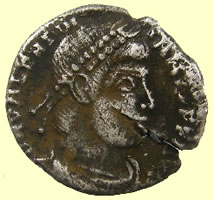  |
|||||||||||||||||||||||||||||||||||||||||||||||||||||||||||||||||||||
Very crisp 4thC Roman silver sent for ID Wow, very nice. This is, of course, a Siliqua of Valentinian, I 364-375. From the mint at Arles, it dates to the earlier part of his reign, 364-7. The reverse type is RESTITVTOR REIP - (Restorer of the Republic - pure propaganda) and shows the emperor standing facing, head right, holding a labarum with Chi-Rho symbol and Victory on globe. The OF - II in the field indicates the 2nd offiicina or workshop of the mint, the star above the II is a sequence mark.
Mark |
|||||||||||||||||||||||||||||||||||||||||||||||||||||||||||||||||||||
  |
|||||||||||||||||||||||||||||||||||||||||||||||||||||||||||||||||||||
| 2ndC Roman silver coin - cooking to remove crust | |||||||||||||||||||||||||||||||||||||||||||||||||||||||||||||||||||||
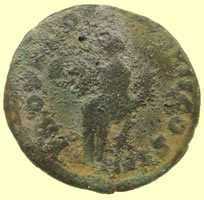  |
|||||||||||||||||||||||||||||||||||||||||||||||||||||||||||||||||||||
Interesting find yesterday, is it silver, debased or washed ? Not attemping to clean it until I know it will not be damaged. - Mindy Roman silver coin sent to Mark Lehman for ID Can you see exposed copper on this one? I believe it is a standard (official issue) silver (at least 50-60% or so) denarius of Marcus Auelius (161-180) so you might want to check to be sure that it's not just profoundly tarnished and possibly cleanable silver. There is an entire class of cast (generally, rather than struck) denarii and a few earlier antoniniani which were made by impressing genuine coins in clay to make molds. They can be surprisingly close to the originals, particuarly as castings go, and when found in perfect condition may retain a very thin silvery outer layer, but generally appear to be strictly Æ. These are mostly found in the Balkans and the era in which they were commonly produced was from about 200-250 AD - at least the protoype coins from which the molds were made tend to be from that era - coins predominantly of the Severan dynasty. These are incorrectly referred to as "Limes Denarii" - and although this is a terrible name for them (it conflates them with the class of "Limes Falsa" undersized, struck contemporary copies of Julio-Claudian Æ from Britain and Northern Gaul - with which they share virtually no qualities other than both being contemporary copies) they have now been referred to by this term long enough that it has achieved a certain legitimacy and it would probably be impossible to convince the market in general to stop using this misnomer-name for them. These Balkan Æ denarii used to be quite scarce until the 1990's when huge quantities of coin began to reach western markets from the former "Iron Curtain" countries like Bulgaria, Romania, the countries of the former Yugoslavia, and the most south-western of the nations formely part of the Soviet Union like Ukraine. Now they are not exactly "common", but just about everyone has seen them in person now and most folks I know have at least a few of them sourced from lots of uncleaned coins alongside Roman Provincial and Constantinian-era material. I'm not saying this marcus Aurelius cannot be a contemporary copy, but unless you're certain it isn't silver, I'd assume it's a regular Mint of Rome product. For comparison, here's a pretty early (the prototype dates to 198 AD), so-called "Limes denarius" of Septimius Severus: This probably would have been at least silvery-colored originally, but by the time we see them, they almost always appear to be Æ, like this one. There is also a class of struck fourrees from this same general era - often mistaken for official issues, they are "silver-washed" (I explained recently why this is also a misnomer but won't repeat it here) at a time before the silvering process had been used on any official Roman coins - that practice didn't occur until the 260's under Gallienus. This "plated" Julia Maesa denarius can be seen obviously not to be an official denarius from a standpoint of style and workmanship as well as fabric, but unlike the fourrees of the 1st century BC & AD, the Æ core is not wrapped in a silver foil - rather it appears to have been created by surface enrichment: It should look like this: Let me know what alloy the Marcus Aurelius turns out to be - if it is a Balkan copy, it would be the earliest example of the type I've ever seen. Mark |
|||||||||||||||||||||||||||||||||||||||||||||||||||||||||||||||||||||
  |
|||||||||||||||||||||||||||||||||||||||||||||||||||||||||||||||||||||
Roman silver coin - sent for ID before cooking - Ron The only place I can find the reverse legend (which is about all that I can make out on this piece at this point) is on denarii of Septimius Severus and Caracalla. (c. 193-217) It reads: PART MAX PONT TR P IIII - it should show 2 captives seated at the foot of a trophy. So yes, this should definitely be pretty good silver (unless you have some reason to suspect a fourree, it should be better than 50% at any rate) and a candidate for cooking. When some of the crud on the obverse falls away, I should be able to tell you whether this belongs to father (Sept Sev) or son (Caracalla) - or someone else. This is also interesting in that you have shown me very little material from the Severan Dynasty overall - it's made itself pretty obvious by its near complete absence from the record of coin-types you've found, while Severan coins, in general, are not at all scarce anywhere else. Mark |
|||||||||||||||||||||||||||||||||||||||||||||||||||||||||||||||||||||
  |
|||||||||||||||||||||||||||||||||||||||||||||||||||||||||||||||||||||
Roman silver forgery - sent for ID Great relic as it shows clearly the two sheet of silver over a bronze core Now that is some real "core exposure". This is actually quite the "exploded diagram" of a textbook 1st century fourree. The copper core was wrapped in a significantly thick silver foil with a layer of flux applied under the silver which was then "soldered" to the core by annealing. Usually, you only see holes in the foil -"core exposures", although I have occasionally seen an empty silver shell (or approxiamtely 90% or one, at least) from which the copper core has been completely corroded away and lost. This appears to copy a denarius of Vespasian, although it could as easily be meant to be Titus - the beginning and end of the legend having been lost makes it impossible to be sure, but the portrait favors Vespasian. The reverse seems to be COS ITER TR POT with Aequitas standing left, the scales she holds are lost just below the break in the silver. This reverse is an exclusively Vespasian type, but it's not at all unusual for fourrees to mule obverses with "inappropriate" reverses. In fact, I used to own a fourree of an Otho denarius (see photo below) with this same Aequitas COS ITER TR POT reverse, so this doesn't prove it's not Titus either. Vespasian's 2nd consulship began in 70 AD, so this piece can't date to much later than 80 AD without the reverse being so anachronistic as to have caused suspicion. Mark |
|||||||||||||||||||||||||||||||||||||||||||||||||||||||||||||||||||||
1.01g,16.44mm & 1.0g,13.59mm Amazing find - the before and after clipped Roman silver hoard coins that now weigh the same as the larger one is really thin. Ill Tim found both together I doubt rather seriously that any clipping of Æ coins went on in the later Roman Empire - it just wasn't worth it any more than trimming a sliver of paper off a banknote would be. Still, many folks insist they have "clipped" examples of Æ coins. What they typically have is an example of a smaller denomination struck with the dies intended for a larger denomination or simply on skimpy flans - so skimpy that the coins so produced wind up so much smaller that they may be mistaken for a different denomination. These however, seem to be silver. So, rather than some enterprising merchant shaving slivers of silver from coins passing through his hands, what you have here is 2 different denominations representing 2 different time-frames - and the smaller of the two was created officially rather than serruptitiously. The smaller piece is an example of what happened to much of the circulating stock of siliquae after the Romans packed-up and left - it was officially cut down to the size and approximate weight of a Saxon Sceat. I'm not 100% certain that the smaller one is also of Honorius, despite the similarity in portrait. Arcadius, Theodosius II and Constantine III struck the exact same reverse and there was significant overlap in their years of rule. I can't be completely certain from the little seriphs which are all that remain of the letters, but I would hazard a guess that it is Honorius. Theodosius can often be mistaken for Honorius and vice-versa due to the O's. Mark
1.44g, 13.25mm - Covered with thick horn silver crust Chicgao Ron found a 3rd that is really thick with horn silver crust.
2ndC Roman silver coin sent for ID - cooking to remove crust (Ed) - resent for update on ID We will need to see what appears on the obverse - particularly in the legend - before I can be completely certain who this is beyond "an Antonine woman". It's highly unlikely to be Faustina Sr. since the main body of her coinage is posthumous and the reverse type - PVDICITIA - would be a quality or virtue only of a living woman. I suspect Faustina Jr. for the following reasons: The shape of the head and the hair style seem to strongly suggest the Antonine era, and although it could be either Faustina Jr. (issued under Antoninus Pius or Marcus Aurelius), Lucilla or Crispina, the length of the obverse legend suggested under the encrustation is likely only on a coin of Faustina Jr. But we'll have to wait and see what the cooker reveals on the obverse. Mark Now that we can read (or at least puzzle-out) the obverse legend well enough to be certain that it reads: FAVSTINA AVGVS-TA AVG PII F = "Faustina, Augusta, Devoted Daughter of the Emperor" She was honored as Augusta in her own right when her mother died in 147, this was several years before before her husband, M. Aurelius was made Augustus (161). She married Marcus Aurelius in 145 and died a few years before him in 175. We can now be certain that this is a lifetime issue for Faustina Jr. which was issued by authority of her father, Antoninus Pius. This issue dates to 156-7 from the mint at Rome. This is an unusual form of obverse legend and is almost unique to this specific type, although this type is not considered particularly scarce. References include: RIC III 508a; RSC 184; BMC1092; and SRCV 4707. Mark
Roman silver coin fragment sent for ID The silver fragment is from a denarius of Septimius Severus, 193-210 AD. I can't tell from the remaining features what the reverse type may have been - and Sept. Sev. was a very prolific issuer of different reverse types on his denarii. Although the device might appear to be a highly unusual tubby personification, I think this is the result of encrustation appearing to be part of the relief. From the couple of letters visible at the lower left, it might be "PROVIDENTIA..." but generally a standing representation of Providence will be holding a wand and/or pointing at a globe at her feet. It's not impossible that this was what was originally happening on this coin's reverse, but it's one of those "best guess" situations at this point.
5thC Roman hammered silver coin sent for ID 1.08g, 20mm dia It's obviously Theodosius - you can read his name quite easily. The question remains, though, "which Theodosius?" Theodosius I who was part of what I like to call "The Valentinian Dynasty" reigned during the late 4th century. His dates were 379-395. Then there's Theodosius II from 402-450. This one - VIRTVS ROMANORVM - with Roma seated left holding Victory and spear with mint mark MDPS would be Theodosius I from the Mint of Milan. These are not easily datable to specific years or groups of years - the same type was minted throughout his reign and during several others including that of Theodosius II. Theo II, however, did not strike at Milan - and his coins are far scarcer. The references for your piece are RIC IX 32a and RSC 57b. Mark
2nd C Roman silver coin sent for provisional ID - cannot ' cook' this coin as it is part of new hoard I just reported 2.98g, 19.30mm This is, I'm sure you're aware, sort of a nearly-impossible challenge. However, one thing that "pops out at me" is that the bust appears not to be wearing any crown - no laurel, diadem or radiate is visible, neither are there any perceptable "wreath ties" hanging behind the head/neck. Although the portrait - at least in this vague configuration - does not particularly resemble him, what first comes to mind is Constantius Gallus. He was a short-lived cousin of the sons of Constantine who, never advancing beyond Caesar before he pissed-off Constantius II sufficiently to relieve him of his head altogether, was only ever portrayed bare-headed - as was the custom for Caesars after the death of Constantine I. Here's an example of a Constantius Gallus majorina with unbroken legend: http://www.stoa.org/gallery/album167/39_Gallus_FTR_CYZ_1 A lot of his coinage shows him with a legend broken by his head, but as you can see, the legend is continuous around his head in the example above - this was also a post-Constantinian tradition for new Ceasars or Augusti - the minor or associate was shown with a smaller portrait head accomodating an encircling legend. When he had achieved a certain seniority, his portait was enlarged and the legend broken to accomodate it: Later in his short reign, he was portrayed thusly: http://www.stoa.org/gallery/album167/41_Gallus_FTR_ALE Other folks who were portrayed bare-headed who might be likely to show up in your digs are the brothers Magnentius & Decentius - it was they whose coins formed the bulk of one of the earlier hoards you dealt with - a couple years ago. They tended to be portayed with serious "helmet-hair" as part of a mullet - a very silly-looking hairdo, IOW. Julian II was Caesar for a relatively long time before his relatively brief time as Augustus - his coins as Caesar also portray him bare-headed. http://www.stoa.org/gallery/album167/50_Julian_FTR_ARL Of course, if my initial impression of a bare-headed portrait turns out to be mistaken, all of the preceeding becomes relatively meaningless. Mark
2ndC Roman silver coin sent for ID - cooking to remove crust (GaB) I guess I didn't get back to you on this one - I can't be 100% certain since the obverse legend is all but illegible and the back of the head could be any one of half a dozen young late 2nd-early 3rd century Imperials, but I believe this is a youthful portrait of Caracalla - probably when he was still Caesar under his father, Septimius Severus (195-198). The reverse type is plausible for Caracalla Caesar - PIETAS Piety standing left sacrificing over small altar and holding box of incense. If the obverse leged becomes clearer with cleaning, I suspect it will be "M AVR ANTON CAES PONTIF" - the single really clear letter of the obverse legend - the "O" - is in the correct place for this to be the legend. Mark
Roman silver coin sent for previsional ID - needs a cook to remove crust I'm afraid I can't narrow this one down very much at this time - there are just too many profiles which might possibly match up with this fairly generic and soft-focus, bearded portrait. The obverse legend is no help in its current state. The reverse is too generic to call it for any one ruler with whom it's associated. Mark
3rdC Roman silver forgery sent for ID Can you see a visible area of exposed copper core on this piece in-hand? I can't see any obvious core-exposure in your photos and I don't really see this piece being a contemporary copy or ancient counterfeit at all. It appears to be a fairly good-quality silver Antoninianus of one of the last group of pre-Gallienus emperors. Philip I, Trajan Decius, Trebonianus Gallus, Volusian, Hostilian, Aemilian, etc. There is too little obverse legend and the portrait is a bit too generic - radiate bearded man right - and nothing about the reverse which would allow us to say "Oh, that's a reverse type used by so-and-so" It's another standard, generic standing female personification holding a cornucopiae and could be on anyone's coins. it's unlikely that we will be able to make a really positive ID here. Mark
2ndC Roman silver coin sent for ID
2ndC Roman silver coin - cooking to remove crust
2ndC Roman silver coin - needs cooking to remove crust
2ndC Roman silver coin - needs cooking to remove crust
Cleaning up Roman silver coin - sent for ID Col John What you have here is a silver Siliqua of Gratian, (367-383) the young son of Valentinian I, elevated to Augustus at the age of 7. This piece is from the mint at Trier, the exergual mint mark is TRPS• References are RIC IX, 27f-1; and RSC 86a. This type with Roma holding Victory and a scepter rather than the inverted spear Roma generally holds in her left hand on VRBS ROMA Siliquae dates to the period 367-375. However, considering Roman coins in general, Siliquae are far scarcer than, say, Denarii. I've heard it said that you'll see at least 100 Denarii for every Siliqua you'll ever see - and although I haven't strictly "kept score" or otherwise checked empirical statistics, I'd say that's probably about right. It's a very nice piece which I expect will be quite nice looking after some minor, light cleaning - I wouldn't try to take all of the darker tone off the fields as it will be slightly more valuable with the more "naturally toned" looking appearance that it's probably possible to achieve by gentle cleaning of this very light darkening. Mark
Cooking 2ndC Roman silver coin sent for quick ID My first reaction was to say Trajan from the shape of the head, but then looking at the face more closely, I begin to wonder if it's not one of the Flavians - Vespasian or Titus particularly, or a younger portrait of Domitian. I believe that what we can see of the obverse legend from 2:00-4:00 reads ...[P] M TR P - so that is not particluarly specific to any one ruler. The Tribunician power was almost a guaranteed office of the emperor. I could check to see which emperors used legends which ended in ...P M TR P which will generally also have the rest of the laundry-list of Imperial titles continuing on the reverse. I can't quite make out what the figure is doing on the reverse and what, if any, attributes may be associated. It might be either the Roman numeral II or part of a III or IIII we can see from 3:00-4:00 on the reverse and that would be likely to be the consular number - it was more normal for an emperor to have been consul a few times - very seldom did they hold this office more than 4 or 5 times - so that doesn't do much to narrow-down the field. Let me check the legend lists and see if I can narrow down the possibilities any by seeing who among them used an obverse legend ending in P M TRP. Mark
2ndC Roman silver coin - needs a good 'cook' to remove crust Just a quick word - I'll need more time to tell you about the reverse (and figure it out) but this is an antoninianus of Salonina, the wife of Gallienus, 253-268. This was the period in which the Empire really went off the rails and it was only by the skin of their teeth that Gallienus next two successors managed to pull things back together enough for the Empire not to fragment and dissolve right then. Mark About all I can tell you on the reverse of the Salonina is that it appears to be a personification standing and holding a cornucopiae. The orientation of your photo of the reverse appears to be at around 1:00-1:30. There are either hints of lettering around 10:00 in your photo which make me think it might be "CONCORDIA", but they might just be coincidental spots and stains which appear possible to be letters at this point. If the reverse of this gets any cleaner, I can probably tell you more about it.
2ndC Roman silver coin - needs a good 'cook' to remove crust Don't feel too bad about the silvering - it very seldom survived more than a year or two in circulation and is even less common on dugups. Gallienus (GALLIENVS AVG) was the first emperor to allow an official silvering program - before that it had been strictly a counterfeiters' art - and was used to silver-plate jewelry, etc. They got better at it in subsequent decades as virtually all the Roman "Silver" coinage had just the thin "wash" - not really a wash, it was typically crated by acid "pickling" of the flans, pre-strike, to remove the casting fire-scale and bleach the outer layer. It also resulted in dissolving some of the surface copper and leaving a fine network of microscopic silver "beads" on the surface. When struck, this spread out into a continuous layer only a couple molecules thick (not unlike the extremely thin copper coating on US one cent coins - which have been made of zinc since 1983 - the copper is mainly stabilized by a super-hard, thin, polymer-plastic varnish coating) This "billon" Antoninianus has Laetitia on the reverse (LAETITITA AVG) - she holds a wreath and typically an anchor in the left hand - although not visible in this representation. This may be a later die-state in which the thin shaft of the anchor had been polished off the die. By the fabric, this piece probably dates to 265-7 while the reference, Mint of Rome, RIC V, i 226, RSC 424 carries a date of 262-3. This may, however, be a later issue that is essentially the same as an earlier issue. The range of antoniniani of Gallienus is enormous - there are literally thousands of cataloged types and the occasional un- or mis-cataloged type is not too unusual. Mark
2ndC Roman silver coin - cooking to remove crust - sent to Mark Lehman for his views
'Cooking' Roman silver to remove crust
2ndC Roman silver coin - needs a good 'cook' to remove crust
5thC Roman silver siliqua of Honorius The reason that this coin seems so thin is that it's the way they were made. The Romans were already (and had for some time been) experiencing the shortage of silver which would extend well into "modern" times (taking the long view) and was the reason that medieval deniers all tend to be such fish scales. This is a siliqua of Honorius. Honorius was one of the last of the Western emperors and the one during whose reign the Visigoths sacked Rome in 410 AD.
Honorius ascended to the purple at the age of 9, in 393 AD, so you know there was someone else behind the scenery pulling the strings. He was actually around for a pretty long time as rulers went (and they mostly went) in those days. He survived until 423 AD. but isn't known for much of anything except happening to be in power when Rome was invaded.
Mark
Roman silver coin forgery Although "fourree" silver-over-copper denarii are not terribly uncommon, they tend to be seen more in the Republic and early Imperial era, however. Those silver foil-wrapped copper cores, the foil sealed to the core with flux and the whole package struck with dies was the "standard" for counterfeits - ie: fakes made to deceive and pass current as good silver denarii for a long time.
The reason that this coin seems so thin is that it's the way they were made. The Romans were already (and had for some time been) experiencing the shortage of silver which would extend well into "modern" times (taking the long view) and was the reason that medieval deniers all tend to be such fish scales. This is a siliqua of Honorius. Honorius was one of the last of the Western emperors and the one during whose reign the Visigoths sacked Rome in 410 AD.Honorius ascended to the purple at the age of 9, in 393 AD, so you know there was someone else behind the scenery pulling the strings. He was actually around for a pretty long time as rulers went (and they mostly went) in those days. He survived until 423 AD. but isn't known for much of anything except happening to be in power when Rome was invaded. Mark If I'm interpreting the bottom seriphs of the obverse letters correctly (and I'm pretty certain I am) this is Honorius - D N HONORIVS P F AVG. with reverse, VIRTVS ROMANORVM - Roma seated left on cuirass holding Victory on globe and spear. This one, as significantly clipped as it is (it quite possibly was "officially clipped" in order to bring its weight into line with Saxon Sceats circulating in the late 5th and 6th centuries) has lost all traces of the mint mark. This type and denomination was only minted at the "western" mints, Trier, Milan, Rome, Ravenna and Aquilea, Constantinople struck the Vota types of Siliqua - range of possible years, 397 - 408 AD. considering the production of all mints - since Trier is very rare, 402-408 is a more realistic time-frame for the VIRTVS ROMANORVM Siliquae. Mark
4thC Roman silver coin sent for ID I cannot clean this coin as I just had another one break into 3 pieces - too thin and poor quality silver. This one is already fragmenting at the edges
Fascinating 4thC Roman silver find sent for ID - The structure of this coin under my scope is tiny silver granules very like the Saxon silver pennies that are too brittle to clean. Sent to Mark Lehman for his views. The last Saxon silver we sent we sent to our goldsmith for fixing came back in 8 pieces as it fell apart. This is more commonly seen in silver than in Æ's - although the occasional base-metal piece will have gone so granular as to become brittle and easily broken. It's one of the many things that can happen to coins during their long diagenesis.
2ndC Roman silver coin - needs a good cook to remove crust
Beauty 2ndC Roman silver coin sent to Mark Lehman for ID This is, of course, Hadrian - I'd be surprised if you couldn't recognize him by his portrait - Although part of the obverse legend is off-flan, it's HADRIANVS AVG COS III P P. This is an issue from 137 AD (very late in his reign) from the mint at Rome. References would be RIC II 256; RSC 965 and SRCV 3507. Mark
2ndC Roman silver coin fragment sent to Mark Lehman for ID The fragmentary denarius is either Vespasian or Titus as Caesar, 69-79 AD. (they both used the full name "[...V] ESPASIAN [VS...? AVG...? DIVI F...?]" in counter-clockwise legends on denarii.) That's exactly all that is legible on the fragment - lucky for us because it contains a lot more useful specific information than we could have otherwise hoped for on such a tiny fragment.
Crusty 2ndC Roman silver coin - needs a good cook to remove horn crust The other piece shows a lot of detail - in sort of a "dumpy pointillist" manner - but none of the legends are clear enough to get even a single letter. From the thick-necked, "chunky" appearing silhouette (or what it's looking like to me) this might be one of the Flavians, or even, possibly, Nero (or Galba or Vitellius). Its reverse appears to be an enthroned/seated deity, personification or person facing left and posibly holding an object of some sort in its extended right hand (Zeus holding eagle? Pax holding olive-branch?), but there is not much else I can say about it. It should be interesting to see, as these clean up (possibly a longish process, it would appear) just how close my shots-in-the-dark came. Mark
Crusty 2ndC Roman silver coin - needs a good cook to remove horn crust Trajan or Hadrian - I can make out "...[A?, R?] IAN..." on the obverse and the silhouette could be either of them, I guess. On the reverse I believe I can make out ...COS II[?] which would make Hadrian a little more likely Mark
Cooked Roman silver coin sent for ID Chris, This piece was struck at the mint in Rome, Jan.-Sep. 97. Mark
1st to 2nd C Roman silver coin sent for ID - needs a good cook to remove crust
5thC Roman silver coin used by the Saxons to resemble a sceat and used as a pendant Sent to Mark Lehman for his ID I told you I’d get back to you on this one – so far as I can determine from the very few legible letters, this is a siliqua of Gratian, 367-383 AD, the obverse legend should be [D N] GRATIA[NVS P F AVG]. The reverse type is VRBS ROMA with Roma enthroned left holding Victory. The mint mark is fairly unclear, but I think it may be AQP[S] for the mint at Aquilea.
Great double busted Roman silver sent for ID - needs a good cook to remove crust I’m going to need to see this one as it progresses, but on the basis of the family resemblance of the portrait and the fact that the obverse legend appears to be counter-clockwise, it seems very likely to be one of the earlier Julio-Claudians – Julius through Claudius. Send me photos when it’s been cleaned a bit, and I can probably tell you a lot more when the “reverse” becomes legible and/or the portrait on the reverse is clearer and more recognizable .
Roman silver fragment sent for ID I can’t be 100% certain on the basis of so little, but there were very few denarius-issuing emperors who used “COS VIII (or VIIII?) in their coin legends.
Roman silver coin - sent for ID - needs cooking to remove crust Chris,
2ndC Roman silver - needs cooking to remove crust - sent for ID as is an interesting legend under the reverse figure This is one of the early “adoptives” – I’m guessing Trajan or possibly Hadrian – the letters you see in the exergue are describing the device since the long string of titles of the emperor is continued on the reverse “SPQR OPTIMO PRINCIPI…” etc. Okay, now having cracked a book, I can tell you with fair certainty this is a Denarius of Trajan – at least I’d be surprised if it turns out not to be. The bit in the exergue is “ARAB ADQ” marking the acquisition of Arabia in c. 106 – the reverse shows a personification of Arabia standing facing holding branch and bundle of cinnamon sticks, camel at her feet to left. This type dates to c. 113 AD.
Mark
2ndC Roman silver coin sent for ID It’s sort of unfortunate that it appears the finder began scraping off the encrustation because it tends to make the legends much harder to read at this point, but on the basis of what I think I see on the obverse, letters suggesting “…M ANTONINVS…” that can sort of be made out between 7:00 & 10:00 on the obverse, I think this may well be a Denarius of Marcus Aurelius, either late during the time he was Caesar to Antoninus Pius or early in his rule as Augustus – this based on the short, neat beard as opposed to the long and scraggly-tending beard in his later portraits. It might also be Antoninus Pius – I give a couple possible comparative examples below. Unfortunately, silver was never a specific goal for me in collecting, so the examples I have are sparse and nothing that matches yours exactly. The obverse of yur piece also appears to have been somewhat double-struck – you can see doubling in the nose – and that is seldom good news for legend readers. This is from early in M. Aurelius’ time as Augustus And yours stitched and sized in the same format: If the details become clearer under further cleaning, send me photos and I’ll be glad to take another shot at it for you.
4thC Roman silver coin sent for ID This is a silique of Arcadius, 383-408 AD. It’s from the mint of Milan, 397-402 AD. This is quite a decent piece Mark
2ndC Roman silver coin - needs cooking to remove crust Although I really need the diameter to be 100% certain with as little legend as is legible on this one (although I’m pretty certain it’s from the mint of Thessalonica) I feel sure enough to say I think it’s a SPES REIPVBLICE reduced majorina of Constantius II. After the end of the “fallen horseman” reduced majorinae, ca. 355, these skimpy and typically crudely struck and undersized majorinae were struck by both Constantius II and by Julian, as Caesar. They are the last gasp of the original generation of the majorina denomination which was introduced as an Æ2 (much larger) in 348, immediately before the reforms of Julian II restored a Constantinian-sized centenionalis with a Vota reverse.
Constantius II, 337-361 A.D. Æ3/4 reduced bronze majorina
2ndC Roman silver coin - needs cooking to remove crust
Roman silver coin - needs 'cooking'to remove crust 16mm,3.12g
Hoard 1 - 3.17g, 17mm Faustina the elder, wife of Antoninus Pius and mother of Faustina the younger. Posthumous issue by Antoninus pius, Faustina died 141 so it dates between 141-160. Reverse is too profoundly encrusted to determine type, although it might have the legend AVGVSTA (if so, the photo is upside-down) otherwise, it’s a legend ending in “AVG” and could be any of literally dozens of types.
Hoard 2 – 2.89g,18mm Trajan, 96-117, Mars advancing left carrying trophy and holding spear. Not enough of the reverse legend is clear to date it accurately, but the reverse reads something like this: P M TR P (xxx) COS (x VI) P P S P Q R – This seems to be the only piece which does not date to the Severan era in this batch.
Hoard 3 - 3.46g, 17mm Posthumous issue for Faustina the younger by her husband Marcus Aurelius – Faustina II died in 175 and M. Aurelius outlived her until 181 – so that’s the time frame, 175-181. Again, the reverse is so profoundly encrusted that it’s not possible to determine the reverse type
Hoard 4 – 2.48g,15mm Julia Domna, wife of Septimius Severus and mother of Caracalla (and Geta) so her coins’ time frame is 193-217. Obverse: [IVLIA] AVGVSTA. The reverse is IVNO [REGI]NA Juno standing left with peacock at her feet. This type was issued at both Rome and Laodicea (in the mid east) they can only be told apart by style – this appears to be a Rome mint product.
. (young) Caracalla ANTONINVS PIVS AVG / FELICITAS AVGG. Felicitas standing left holding caduceus and cornucopiae (the 2 G’s indicates two co-Augusti, Caracalla and Septimius) Mint of Rome 205 A.D., RIC 124, RSC 64. Roman 2nd/3rdC silver hoard Mark Lehman's initial ID below with poor quality pictures taken on the guys cell phones. I just sent him larger pictures for better ID. Okay, the top left (obverses) is Julia Domna, wife of Septimius Severus – probably issued by Severus, there is another group of coins in her honor struck by Caracalla. This appears to be the fairly common JVNO REGINA, Juno with peacock reverse, but the legend is only partial due to the smallish flan not presenting enough room to strike-up all of the reverse.
Hoard 6 - 3.06g, 18mm Caracalla as Caesar – 195-198. Obverse legend is probably [M AVR ANTON] CAES PONTIF. The reverse is PRINCIPI IVV[ENTVTIS] Caracalla in military garb standing left holding baton and scepter, trophy to his right. Mint of Rome, 197, RIC 13, RSC 505.
Hoard 7 – 3.18g, 18mm Septimius Severus, 193-212. [SEVERVS] PIVS AVG / [VICT] PART MAX Victory walking left holding wreath and palm, Mint of Rome, 204.
Hoard 8 - 3.17g, 17mm . I think what little of the portrait is visible suggests Antoninus Pius, 139-161 – reverse totally obscured but seems to be a figure (possibly Victory) standing or walking left holding object (wreath?) in outstretched right hand.
Hoard 9 &10 – 6.91g,17mm (one coin dia) only part of one coin’s obverse is visible, it looks like it may be “[A]NTON[…] indicating probably Caracalla, reverse is two standing figures and legend is too badly obscured to read, but I suspect it’s a duplicate of # 6 and the reverse is PRINCIPI IVVENTVTIS. 9b reverse is FELICITAS AVG, Felicitas likely standing left holding caduceus and cornucopiae and obverse is too well covered by 9a to be readable at all. Both pieces are almost certainly from the Severan era since that’s pretty much when all the others are on the time line, except for Trajan, of course, and Antoninus Pius. The Severan era included quite a few individuals, both male and female, between 193-238.
Mark Lehman's initial ID below with poor quality pictures taken on the guys cell phones. I just sent him larger pictures for better ID. Okay, the top left (obverses) is Julia Domna, wife of Septimius Severus – probably issued by Severus, there is another group of coins in her honor struck by Caracalla. This appears to be the fairly common JVNO REGINA, Juno with peacock reverse, but the legend is only partial due to the smallish flan not presenting enough room to strike-up all of the reverse. I’ll do what I can to describe and date them on a coin-by-coin basis, but the ones that are totally obscured by deposits and/or corrosion products that weren’t able to be ID’d before are still obscure.
Hoard 11 – 2.67g, 19mm Your photo of the reverse is upside-down – the legend is VOTA PVBLICA – who’s on the obverse is a bit more challenging question, although it looks like one of the youthful Severans.
Hoard 12– 3.07g, 20mm . Julia Domna, wife of Septimius Severus (193-217) IV[LIA] AVGVSTA draped bust right / HILARITAS Hilaritas standing left holding palm-branch and cornucopiae, Caracalla and Geta as children to her left and right. Struck 208, RIC 557; RSC 79
Hoard 13- 2.70g, 19mm Vespasian (69-79) [IMP C]AESAR VESPASIANV[S AVG] (counter-clockwise) laureate head of Vespasian right / TR POT X COS VIII naked radiate figure standing facing atop rostral column, struck 79. RIC (119 old vol II)- 1064-5; RSC 559. It should be obvious that this does nt belong to the same hoard/loss as all the similarly encrusted Antonine and Severan denarii from up to a century and a half later.
Hoard 14 – 3.28g,19mm Septimius Severus (193-211) SEVERVS AVG [PART MAX?] laureate head right / [VICT AETERN?] Victory hovering left holding garland above shield set on base. Struck 200, RIC 170; RSC 670.
Just sent Roman silver hoard coins 11 to 14 off to Mark Lehman for ID
|
|||||||||||||||||||||||||||||||||||||||||||||||||||||||||||||||||||||
  |
  |
Roman silver hoard coin addendum No38 - reported to museum Hoard 38 – 2.87g, 18mm
Geta, Caesar, 198-209. AR denarius, Mint of Rome 203 AD
|
Roman silver hoard coin addendum No39 - reported to museum Hoard 39 -3.06g, 20mm Julia Domna (W. of Sept. Severus) 193-217, AR denarius, Mint of Rome, 208 AD. |
  |
  |
Roman silver hoard coin addendum No40 - reported to museum 3.17g, 19mm Geta, Caesar, 198-209, silver denarius, Mint of Rome, 206 AD. |
Roman silver hoard coin addendum No41 - reported to museum 0.73g,13mm |
  |
  |
Roman silver hoard coin addendum No42 - reported to museum 2.99g,17mm
Mark |
Roman silver hoard coin addendum No43 - reported to museum 3.30g, 19mm Caracalla, 198-217 AD. AR denarius, Mint of Rome, 205 AD. Mark |
  |
 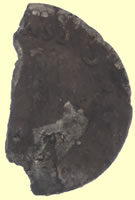 |
Roman silver hoard coin addendum No44 - reported to museum 3.22g, 19.13g |
2ndC Roman silver coin - need cooking to remove crust |
2nd C Roman silver coin - needs cooking to remove crust |
|
  |
  |
4thC Roman silver coin - meeds cooking to remove crust Yep, you’re right, not too much to go on. |
2ndC Roman silver coin sent for ID This one is definitely Trajan as well – and I’ve cataloged about half a dozen of this type in the last couple weeks – Felicitas holding caduceus and cornucopiae. The photo below shows how similar it is, although the legends don’t match exactly – there was a whole series of “Felicitas standing” denarii, with altar, leaning on column, etc – this is the closest I have in saved photos |
  |
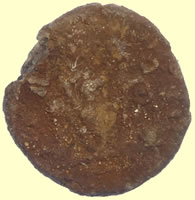  |
2ndC Roman silver coin sent for ID This is a denarius of Trajan, so far as I can tell. At first glance I was not immediately familiar with the reverse type (odd, since I’ve been helping catalog an enormous Trajan specialty collection over the last couple of months, but then Trajan had a lot of types and I thought I hadn’t encountered this one before.) |
2ndC Roman silver coin - needs 'cooking' to remove crust Antoninus Pius, 138-161 AD. AR denarius, Mint of Rome, |
Crusty Roman silver coin - 'cooking' to remove crust Cleaned up mint - sent for ID
|
|
  |
  |
Interesting Roman silver coin sent for ID Titus. AD 79-81. AR Denarius (17mm, 3.19 g, 7h). Rome mint. Struck January-June AD 80. Laureate head right / Elephant, wearing armor, standing left. RIC II 115; RSC 303 |
Roman silver coin - needs cooking to remove crust |
  |
 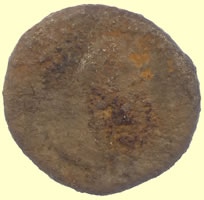 |
2ndC Roman silver coin sent for ID This is Antoninus Pius, 138-161 AD, successor to Hadrian Mark |
Roman silver coin - reported as potential hoard 3.01g,19.55mm |
  |
  |
Roman silver coin - reported as potential hoard 3.57g,17.04mm |
Roman silver coin - non hoard 18.05mm,2.04g |
  |
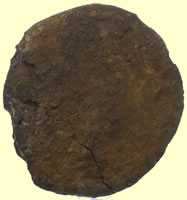  |
Roman silver coin - reported as potential hoard 3.42g,17.98mm |
Crusty Roman silver - needs 'cooking' to reveal detail |
  |
|
| Roman silver coin - needs cooking to reveal detail | |
2ndC Roman silver coin - sent for ID 2.88g,17.41mm Very nice – I’m sure I don’t need to tell you this is Domitian since the name is so clearly readable on the obverse. He was Vespasian’s younger son and the last of Suetonius’ “12 Caesars”, that’s Gaius Julius through the Flavian dynasty, ~ the end of the 1st century AD. He also came to be hated and feared nearly on a level with folks like Caligula and Nero due to his increasing paranoia and reactionary policies. Domitian, (81-96) as Caesar under Vespasian, 69-79 AD. AR denarius, Mint of Rome, 79 AD. |
|
  |
  |
Crusty Roman silver sent for ID 2.70g ,18.24mm I won’t be able to tell you much about a piece at this level of legibility. As far as I can tell from what the outline of the portrait seems to be, it’s probably/possibly Antoninus Pius. No guarantee that’s correct and without more detail there’s really nothing I can add about the reverse, etc. |
2ndC Roman silver coin - hoard addendum reported to museum 2.16g,17.34mm |
  |
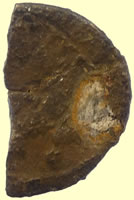  |
4thC Roman silver coin - looks like a siliqua of Gratian, 367-383 AD - sent for ID The reverse type is VRBS ROMA with Roma enthroned left holding Victory. 0.93g, 15.36mm |
2ndC Roman silver coin - need cooking to remove crust |
Crisp Roman silver coin sent for ID 2.62g,18.35mm Hadrian, 117-138 A.D. AR denarius, Mint of Rome, 135 A.D. Nice one for a dugup in agricultural fields. You got this one more or less just in time before it suffered more significant degradation from the fertilizers and pesticides. Mark |
|
  |
  |
| Roman silver forgery | 2ndC Roman silver coin - need cooking to remove crust |
Roman silver hoard coin addendum No47 - reported to museum and sent for ID This one is Caracalla, 198-217 A.D. AR denarius, Mint of Rome, 199 A.D. |
|
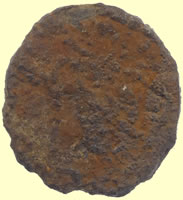  |
  |
| Crusty Roman silver with unusual detail showing through that our expert Mark might be able to ID before cooking. | Roman silver hoard coin 1 (RF)- reported to museum and sent for ID Hadrian, 117-138 AD. Mark |
Roman silver hoard coin addendum No45 (PS) - reported to museum and sent for ID 2.56g,17.03mm Commodus. Son of Marcus Aurelius, his sole reign marked the end of the era of “The Good Emperors”. He slowly went crazy, and by the end of his reign/life had convinced himself he was the reincarnation of Hercules and was regularly fighting wild beasts in the arena. This was not considered correct or appropriate behavior for an emperor, to say the least – plus he was an all-around shit to everyone, highly paranoid, and tended to have any foe, real or imagined, executed. He was portrayed, extremely inaccurately from an historical standpoint, as the main antagonist in the movie “Gladiator”. They made him evil enough, but nowhere nearly so bat-poo unhinged as he was in real life. Commodus, sole reign, 180-192 A.D. AR denarius issued 186 A.D.
Mark |
|
Roman silver hoard coin addendum No46 (PS) - reported to museum and sent for ID 2.79g,18.68mm Continuing with the theme of less-than-pleasant emperors: Caracalla (198-217 AD), as co-emperor with Septimius Severus, 198-209 AD. AR denarius, issued 207 AD. Rx: PONTIF TR P X COS II securitas enthroned right, at her ease in seat with cornucopiae as arms; head propped on right hand, holding scepter with left; small altar before her. Mark |
|
  |
  |
Roman silver hoard coin 2 (RF) - reported to museum and sent for ID Probably Trajan, 98-117 AD. |
Roman silver hoard coin 4 (RF)- reported to museum and sent for ID Hadrian, 117-138 AD.
Mark |
  |
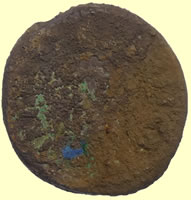  |
Roman silver hoard coin 5 (RF)- reported to museum and sent for ID I suspect this is Hadrian too, (117-138 AD.) and possibly a “LIB PVB” AR denarius like Mark |
Roman silver hoard coin 6 (RF)- reported to museum and sent for ID I’m pretty sure this is Antoninus Pius (138-161 AD.) another AR denarius. |
  |
  |
Roman silver hoard coin 7 (RF)- reported to museum and sent for ID Antoninus Pius, 138-161 AD. |
Roman silver hoard coin 9 (RF) - reported to museum and sent for ID # 9 |
  |
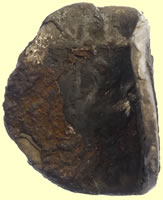  |
| 2ndC Roman silver coin - needs cooking to remove crust | First Taco'd Roman silver coin I have seen - needs serious cooking to remove crust |
|
  |
| Roman silver coin fragments | Roman silver hoard coin 8 (RF) - reported to museum and sent for ID # 8 is from half a century or more prior to the other pieces in the “hoard” so far – which all seem to be of the adoptives and Antonines.
Mark |
  |
  |
Tiberius Caesar Augustus was the second Roman emperor, reigning from AD 14 to 37 You have here two so-called “tribute pennies” – Tiberius basically only issued a single type of denarius in any quantity throughout his long (~ 23 years) rein so they’re really not in the least “rare” in the greater sense. |
|
  |
  |
| Crusty silver Roman coin | 1st C Roman silver coin sent for ID Roman Imperial AR denarius
Mark |
  |
  |
1st C Roman silver coin sent for ID Not much left here for me to go on for details – I can tell you what it is, but can’t give you any catalog # Mark Lehman |
1st C Roman silver coin sent for ID Roman Imperial AR Siliqua (probably a single siliqua – no metrics and more than one possible denomination)
Mark |
    |
|
| Nice find – Nero is always in demand! Nero, 54-68 A.D. AR denarius Mint of Rome, 64-65 A.D. Obv: (probably – legend is very weak) [NERO CAESAR] AVGVSTVS laureate head of Nero right Rev: [CONCORDIA AV]GVSTA Concordia seated left holding patera and cornucopiae RIC I 49; RSC 67; SRCV 1942 Mark |
|
  |
|
| BC Roman silver coin - needs cooking to remove 'horn' crust | |
2nd C Roman silver coin - sent for ID It's Marcus Aurelius, as you probably are already aware - the long, pointed beard and curly hair should make this easily identifiable as Aurelius. |
|
Great detail on this 2nd C Roman silver - just sent for ID |
|
Roman silver coin sent for ID above is a denarius of Trajan, 96-117 AD. Obv: IMP TRAIANO AVG GER DAC P M TR P COS V P P laureate bust of Trajan right, drapery on left shoulder Mark
2nd C Roman silver coin |
|
Roman silver coin - sent for ID - 'cooking' to remove crust 96-117 AD. This is obviously Trajan and very likely a denarius or Provincial drachma It’s not easy to see, but this is another example of the so-called “Capitoline wolf” – the ancient bronze statue of the she-wolf. Self-explanatory to the typical Roman, it didn’t need the pair of suckling twins which added in the renaissance with which it is displayed today (in the Vatican? – not sure where, but it’s a famous museum). |
|
Roman silver coin - sent for ID This is a weird one to find in Britain! It appears to be a Roman Provincial issue from somewhere in the east. It seems to portray either Septimius Severus or Marcus Aurelius. Fun fact: Severus declared himself "adopted" by, and the heir to Marcus Aurelius' fame and auctoritas. Aurelius had been dead for almost 20 years, so he wasn't in any position to object. The "crown" he's wearing looks sort of like ivy leaves, so, maybe Dionysos? He's not usually bearded... Mark |
|
Valentinian II, AD. 375-392 |
|
Just enough detail on this broken Roman silver - sent it off for Mark's views This is most of an AR (it's better silver than would be used a couple of years later) antoninianus of Salonina - wife of Gallienus (253-268) - during the years while he was co-emperor with his father, Valerian I (253-260) - you may notice the reverse legend ends in AVGG, the two G's indicating multiple emperors. |
|
5thC Roman silver coin sent for ID Here's your first AR - a siliqua, I presume (about the size of an old AR or CU-NI threepence, isn't it?) Mark Lehman
Crisp 2ndC Roman silver sent for ID Trajan, 96-117 A.D. AR denarius (your metrology here)
Roman silver coin fragments
|
|
2ndC Roman silver coin - needs cooking to remove crust
Vespasian, 1 July 69 - 24 June 79 A.D., Judaea Capta RS96732. Silver denarius, RIC II-1 2; Hendin 6509; BMCRE II 35; RSC II 226; Hunter I 18; SRCV I 2296
2ndC Roman silver coin sent for ID Obv: IMP CAESAR TRAIANVS HADRIANVS AVG |
|






